Floor Desk Setup in Germany
“My setup might look unconventional at first glance, but it’s very intentional”
Being productive at home is about getting the right things done, not everything done. That's why we built Bento Focus.
Name: Dennis Schellenberger
Location: Germany, Frankfurt am Main
Occupation: Scrum Master
Room size: Part of our living room
Cost of setup: ~€7,5K ($8,6K) (mostly MacBook Pro)
Social media: Instagram
Hello! Tell us a bit about yourself
Hello there!
My name is Dennis, I’m 32 years old and have been happily married to my wife for two years — she’s been by my side for over 13 years now.
I originally trained as an IT specialist in system integration and have been working in the IT department of one of Germany’s largest state credit institutions since I was 21.
Over the years, I’ve primarily been responsible for mobile device management systems, and more recently, I’ve taken on the role of Scrum Master, since we transitioned to an agile way of working throughout the company — and I’ve found real joy in this new challenge.
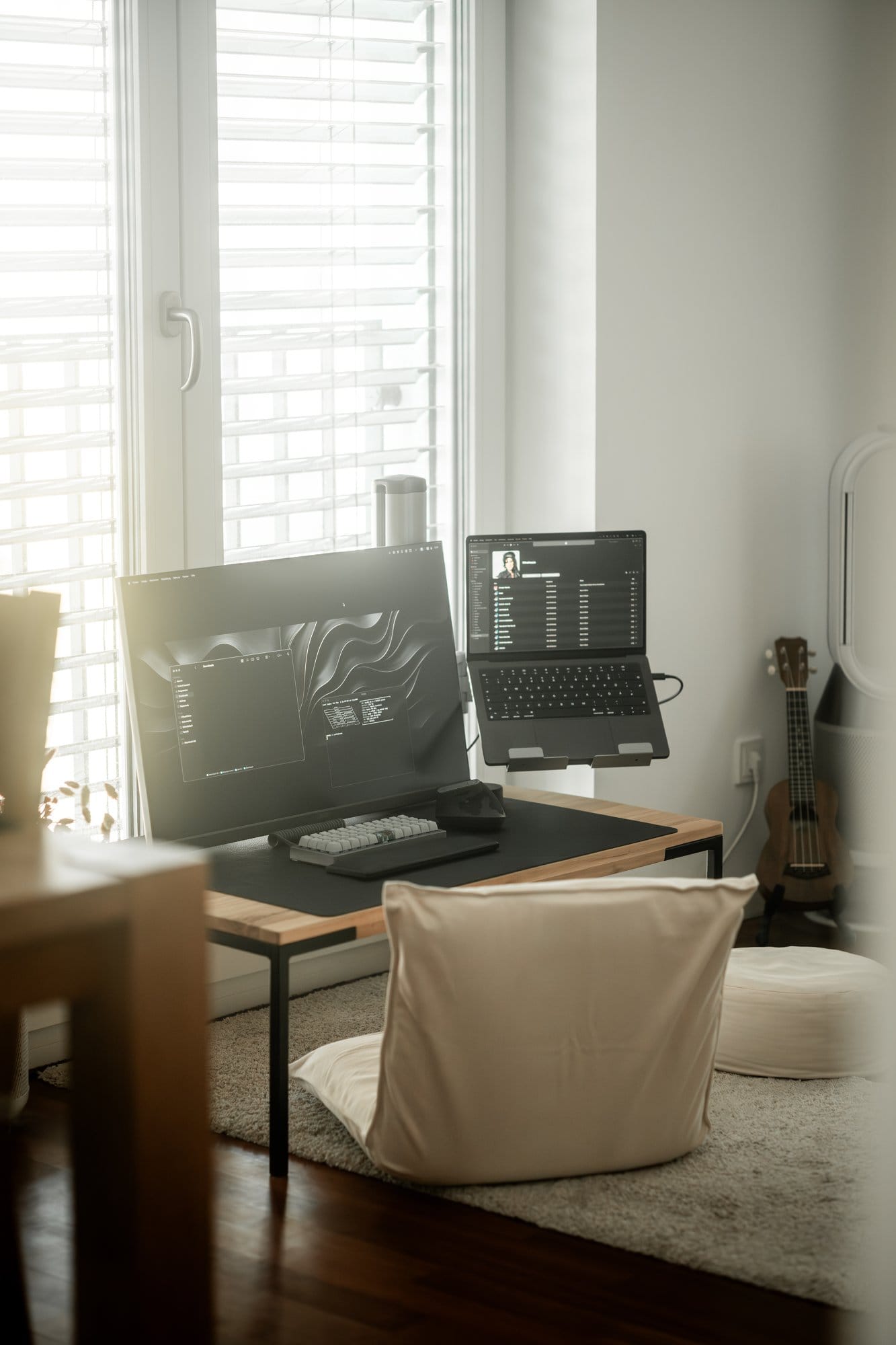
Most of my work is remote, but I usually spend one or two days a week at the office.
Outside of work, I’ve always been passionate about technology — computers, video games, and photography have been long-standing interests of mine.
As a kid of the 90s, I also have a natural soft spot for all things nerdy — like collectible cards, action figures, and retro pop culture.
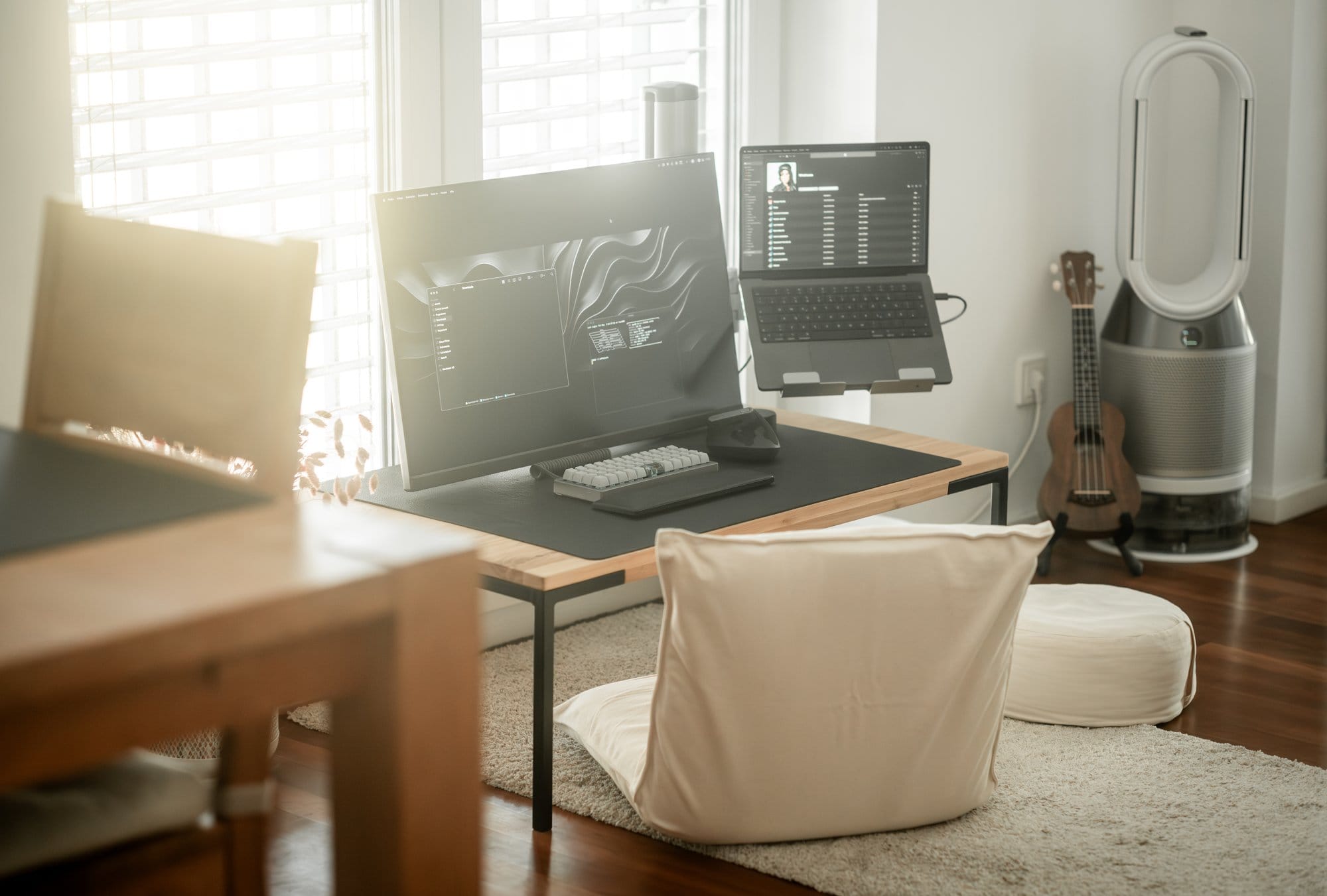
Cooking healthy meals and being more mindful and sustainable in our everyday choices naturally led us toward a more minimalist lifestyle — and it’s something that has truly been good for us.
I do my best to stay calm and grounded, live in the moment, and focus on what truly matters in everyday life.
I love learning new things and continuously strive to grow — both personally and professionally.
Take us through your setup
| Item | Model |
|---|---|
| Monitor | Acer Nitro XV322QUP (32″, 1440P, 165Hz) | Monitor mount | Bretford Desk Mount (Discontinued) |
| Laptop | 14″ MacBook Pro M4 Max (16/40 Cores) |
| Headphones | Apple AirPods Max |
| Keyboard | OLKB Planck (Custom) |
| Mouse | Logitech MX Vertical |
| Desk mat | Black Leather (Custom) |
| Chair | MUJI Floor Chair Yoga Pillow |
| Laptop stand | MOFT 5-in-1 Laptop Stand |
| Docking station | Satechi Thunderbolt 4 Hub |
| Web camera | iPhone Belkin MagSafe Mount |
| Camera | Leica M10 + 75mm/F2 Summicron |
| Knob (Media control, Scrolling) | Binepad KN01 |
| Gamepad | Nintendo Switch Pro Controller |
| Desk mat | Razer Ergonomic Wrist Rest Mini |
Being productive at home is about getting the right things done, not everything done. That's why we built Bento Focus.
Let’s address the elephant in the room right away — yes, I sit on the floor!
My setup might look unconventional at first glance, but it’s very intentional.
I use a floor chair, a soft rug, and a yoga cushion for support, and I constantly switch up my sitting position.
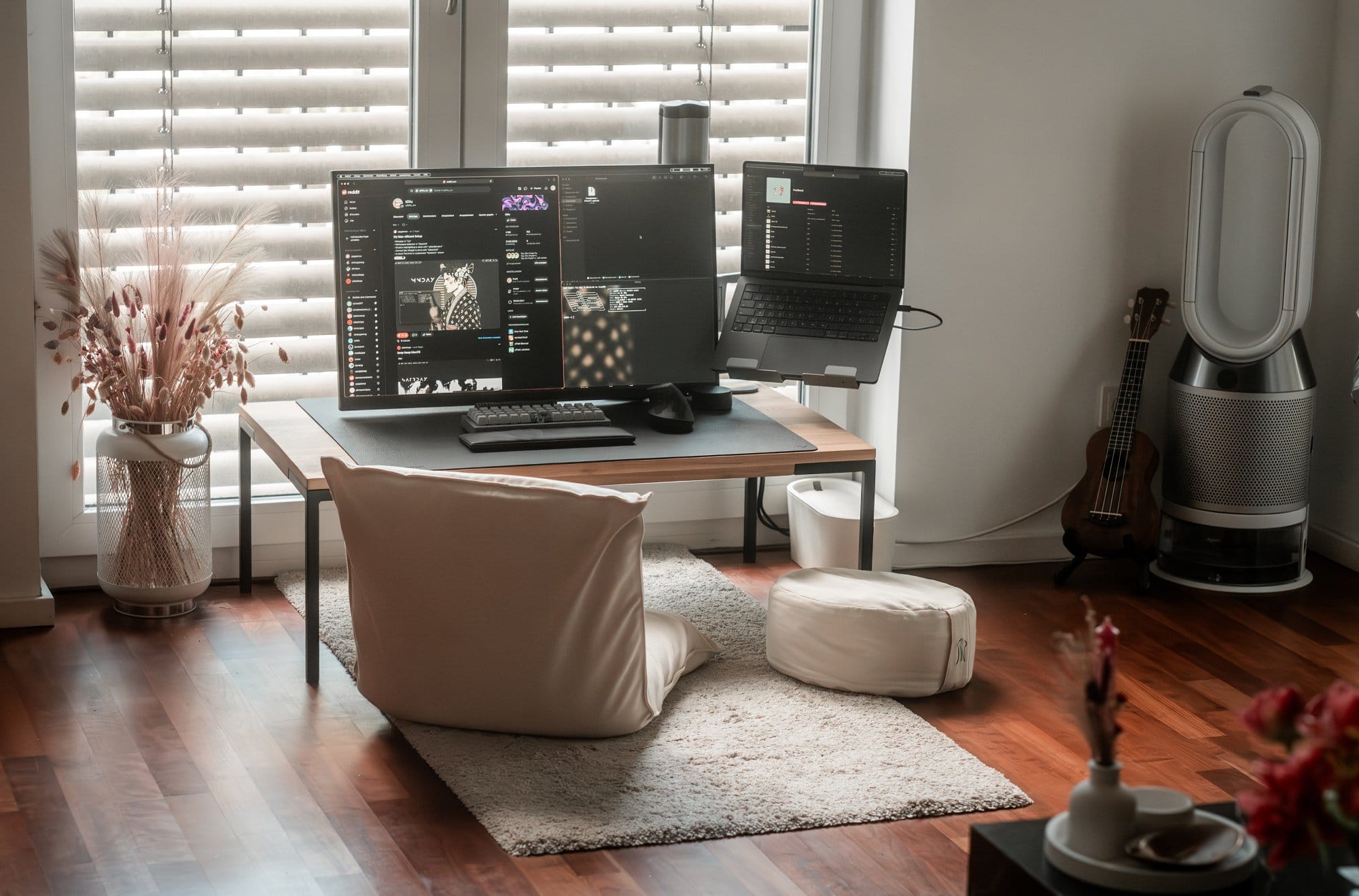
That’s actually the whole idea behind it: sometimes I sit cross-legged, sometimes kneeling or stretching my legs out — it’s never the same for too long.
As I like to say,
“The best position is the next one.”
It might seem odd at first, but this choice has had a surprisingly positive impact on my physical well-being.
Staying dynamic instead of locked into a single ergonomic posture helps with blood circulation, keeps my joints mobile, and has noticeably improved my overall posture and body awareness.
Compared to the stiffness I used to feel after hours in a traditional office chair, I now feel much more balanced and physically engaged throughout the day.
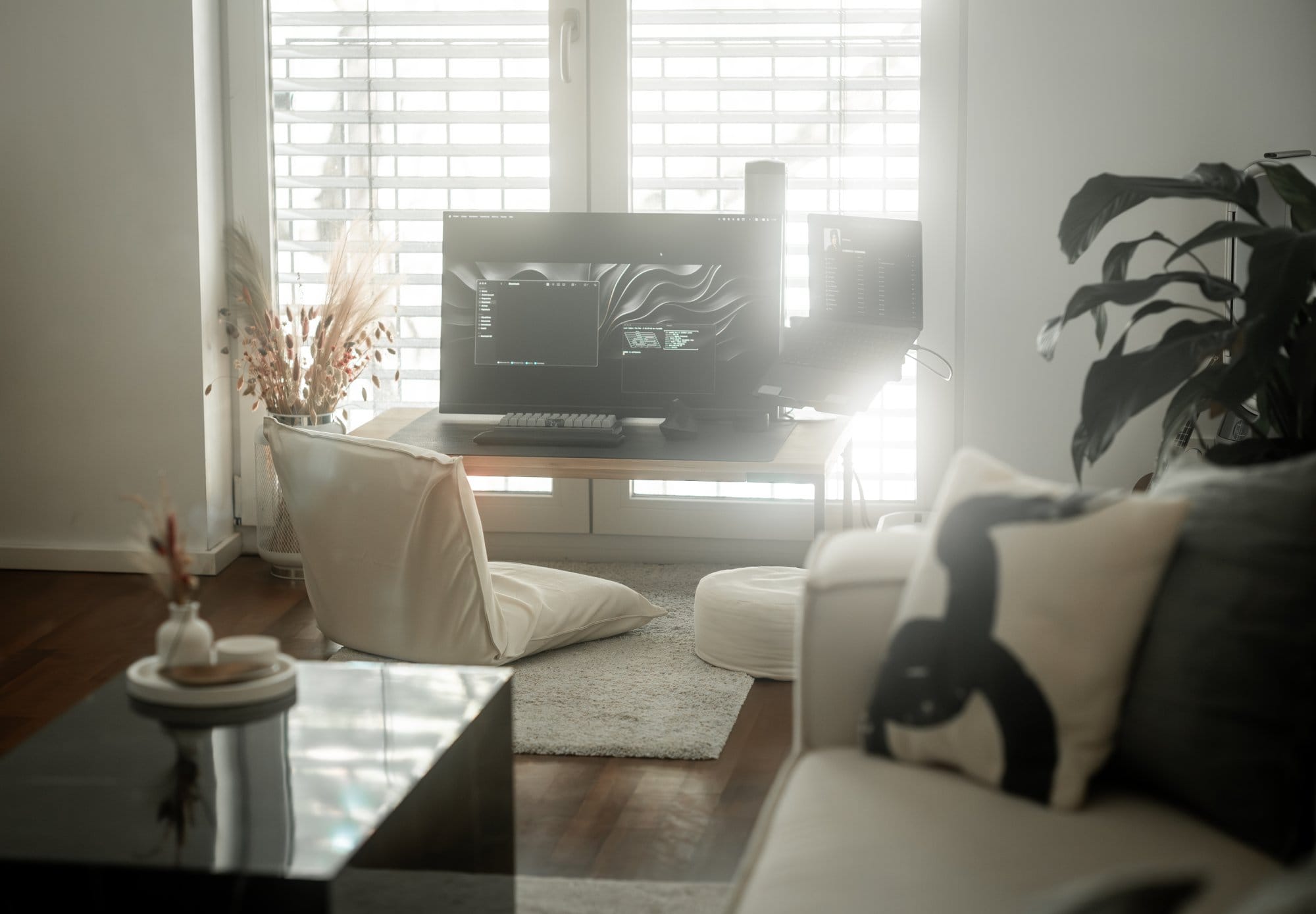
My journey to this setup has been long and experimental.
I’ve had it all: a massive desk, a standing desk, a racing-style gaming chair, a proper ergonomic office chair, even a gym ball — also multiple large monitors, extra peripherals like a Stream Deck or a huge microphone.
And I don’t regret any of those decisions — they were all steps that brought me to where I am now.
In fact, that’s a mindset I try to apply to life in general: never regret past choices, because they shape your experience and help you grow into a version of yourself you’re happy with.
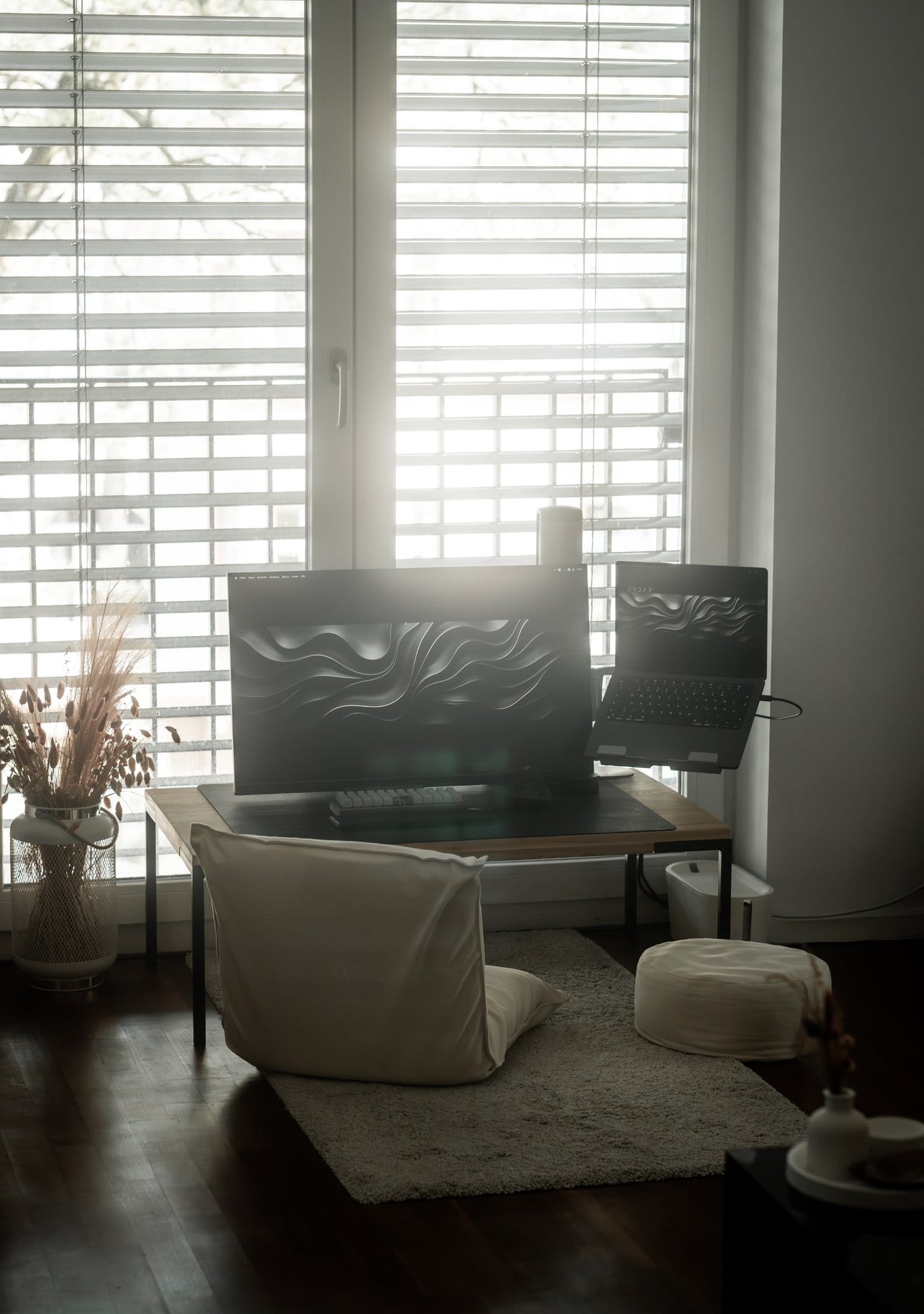
Today, my workspace is in our living room.
I made a conscious choice not to isolate myself in a separate room — I love sharing space with my wife, even if we’re just doing our own things.
Being near her gives me comfort and a sense of presence that I value deeply.
Finding the right table was actually the hardest part of putting this setup together.
I ended up with a simple, no-name coffee table from a furniture store, chosen very specifically for its dimensions — especially the height of 35 cm — and a flat tabletop suitable for mounting my monitor arm.
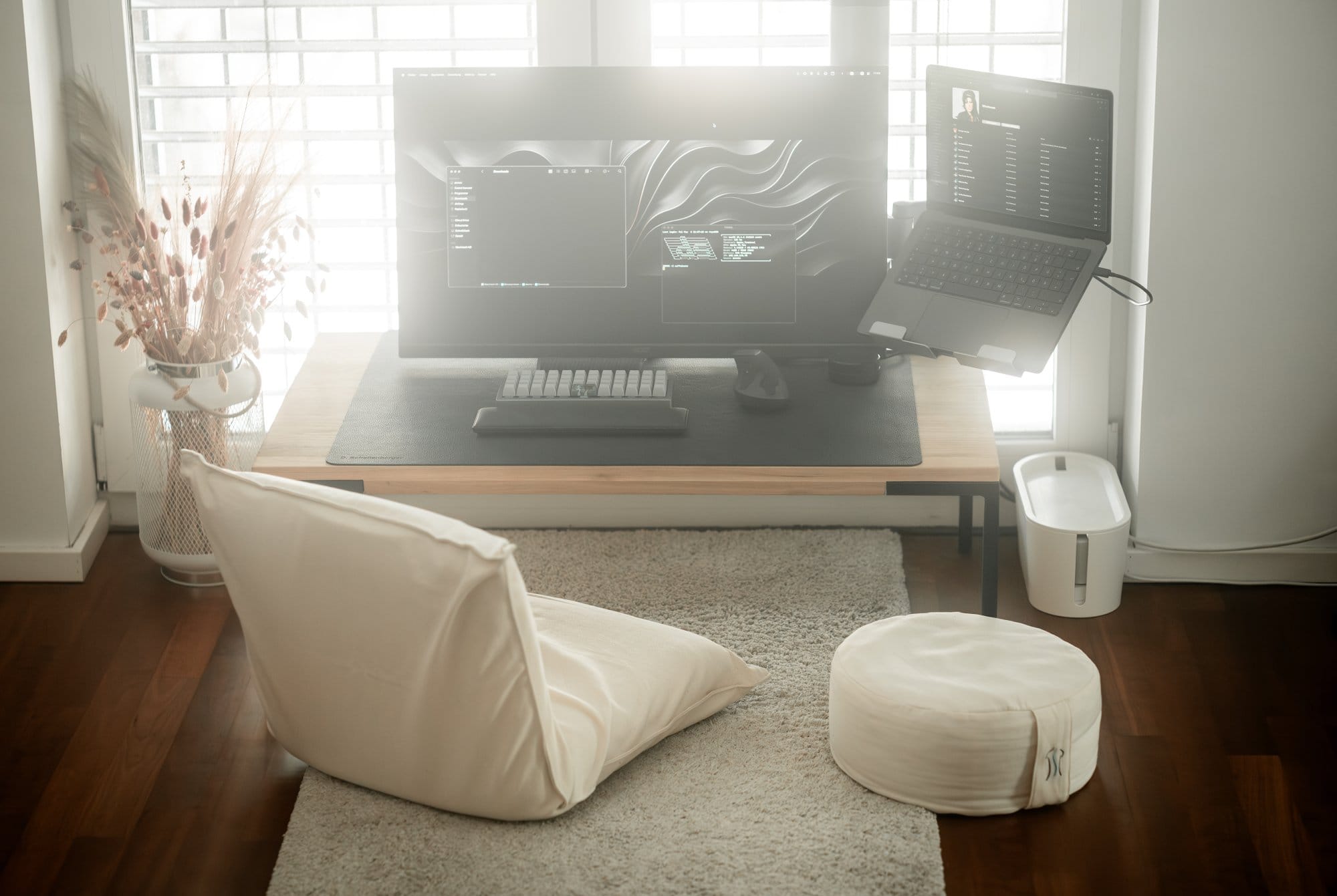
The space is surrounded by floor-to-ceiling windows, which flood the room with natural light.
Our interior design is minimal but warm and cosy, making it a place where I genuinely enjoy spending long hours.
In terms of tech, I keep things simple and focused.
I use a powerful MacBook Pro paired with a single large monitor.
I have completely cut Microsoft’s Windows out of my life and couldn’t be happier with the decision.
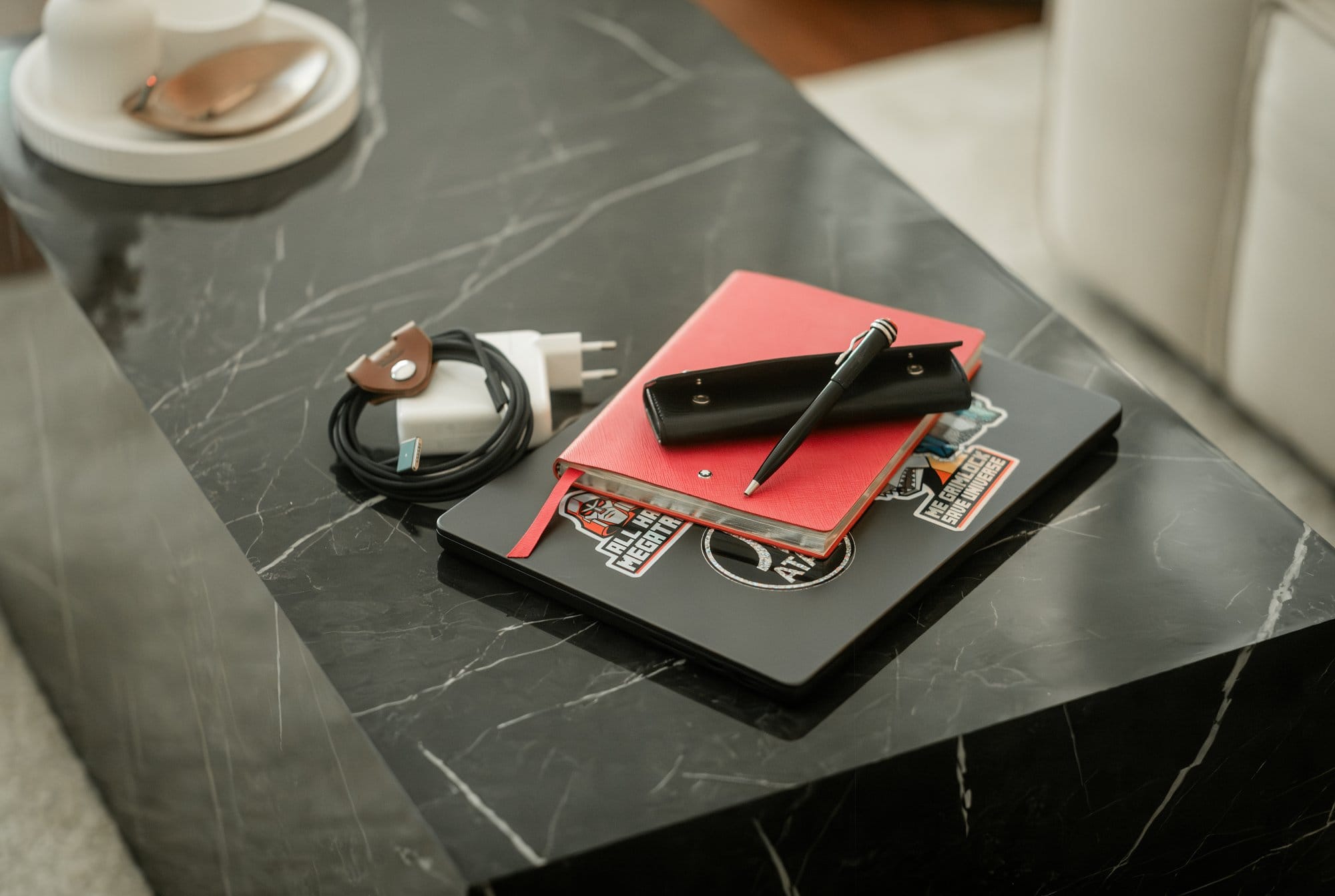
It’s hard to believe, but I’ve stayed true to my hobby and spend a lot of time gaming on the Mac (World of Warcraft, Counter-Strike 2 and many other games can be run on the Mac if you look into the genius tools available today).
For my peripherals, I stay with my beloved small custom mechanical keyboard and a vertical mouse.
The only extra input device I use is a programmable knob that controls my system volume — a small but surprisingly satisfying touch.
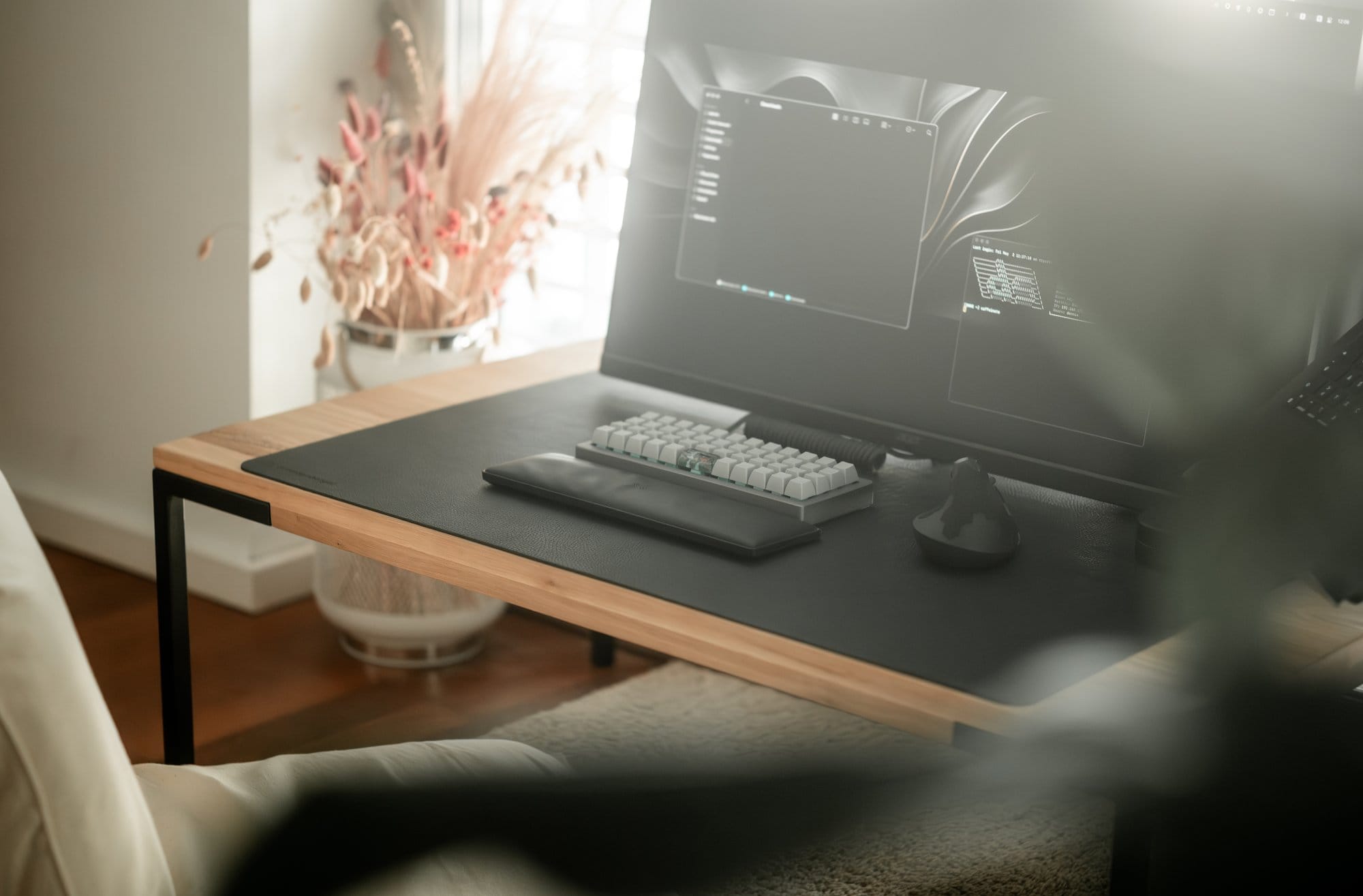
For all audio-related tasks, including calls and meetings, I rely on my AirPods Max, which deliver excellent sound quality and seamless integration with all the Apple devices.
We’ve fully embraced the Apple ecosystem at home, simply because it’s low maintenance and keeps things running smoothly — fewer headaches, less tinkering, more focus on what matters.
What’s your favourite item on your desk?
Without a doubt — my keyboard!
I’ve been fascinated by mechanical keyboards for as long as I can remember, not just for how they feel and sound, but also because of the amazing community and hobby culture surrounding them.
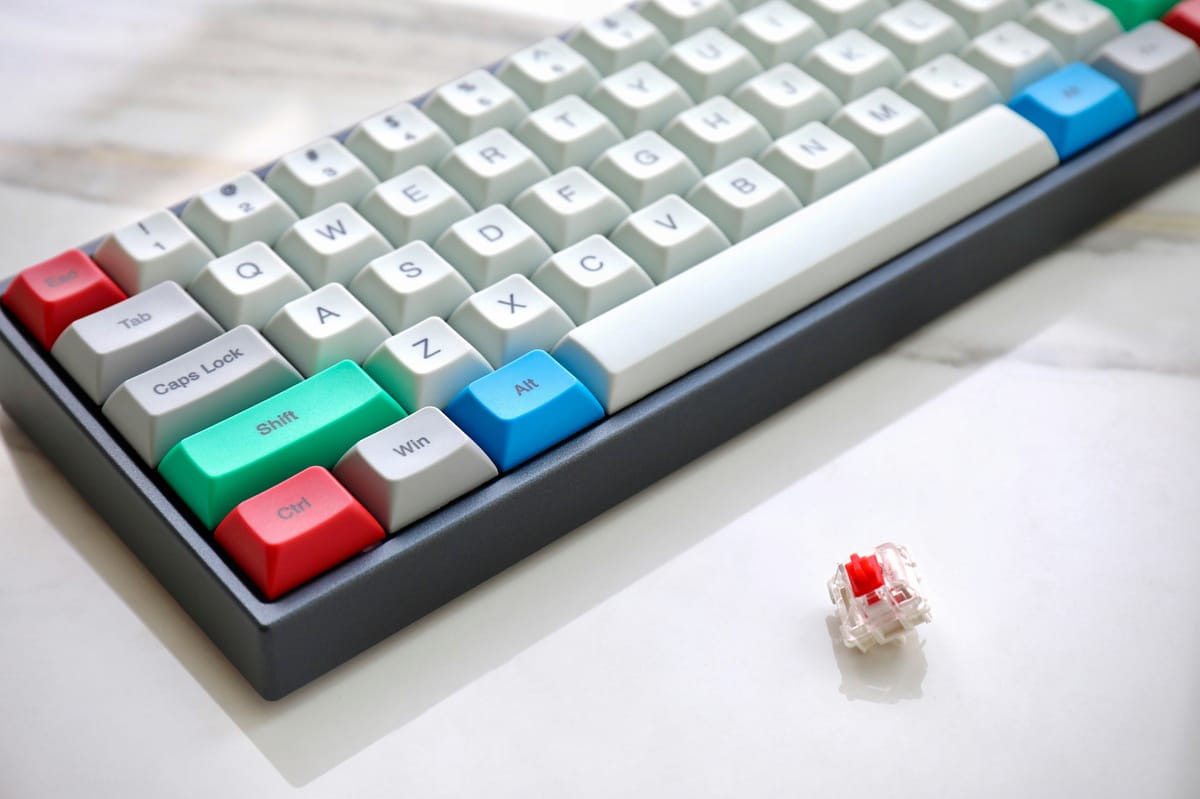
Over the years, I’ve gone through countless boards — both pre-built and fully custom ones that I’ve assembled from scratch.
Some time ago, I made the switch to an ortholinear layout, and honestly, I can’t imagine using anything else now.
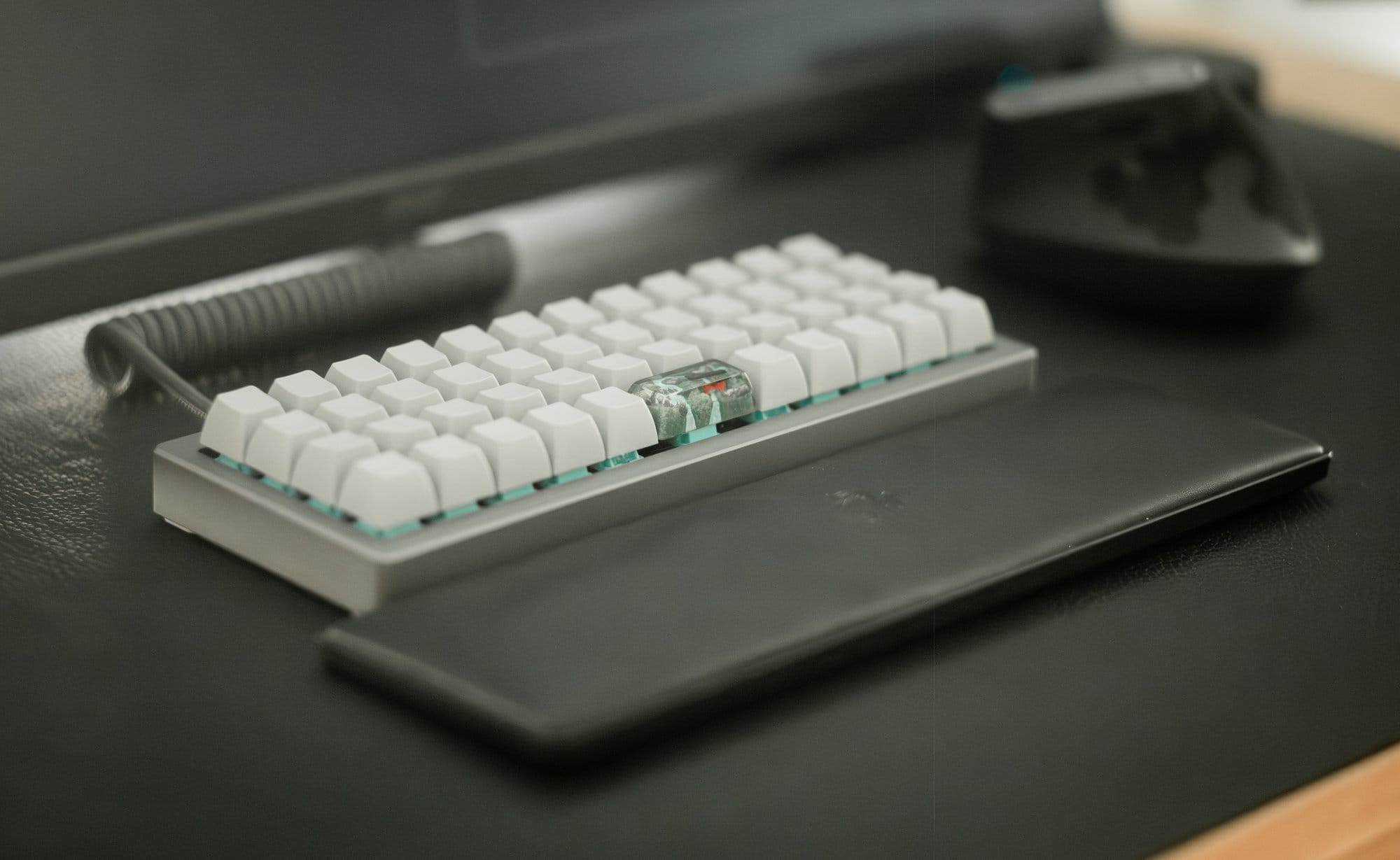
I’ve even stashed a few backup units of my current board in a drawer, just in case — it’s a pretty niche product, and I wouldn’t want to risk being without it if something ever breaks.
The keyboard I use is an OLKB Planck, fully customised to my liking.
It features a heavy aluminium case from KPRepublic, buttery-smooth Aflion Melody switches, tall SA profile keycaps, and a coiled USB-C cable that adds just the right amount of flair.
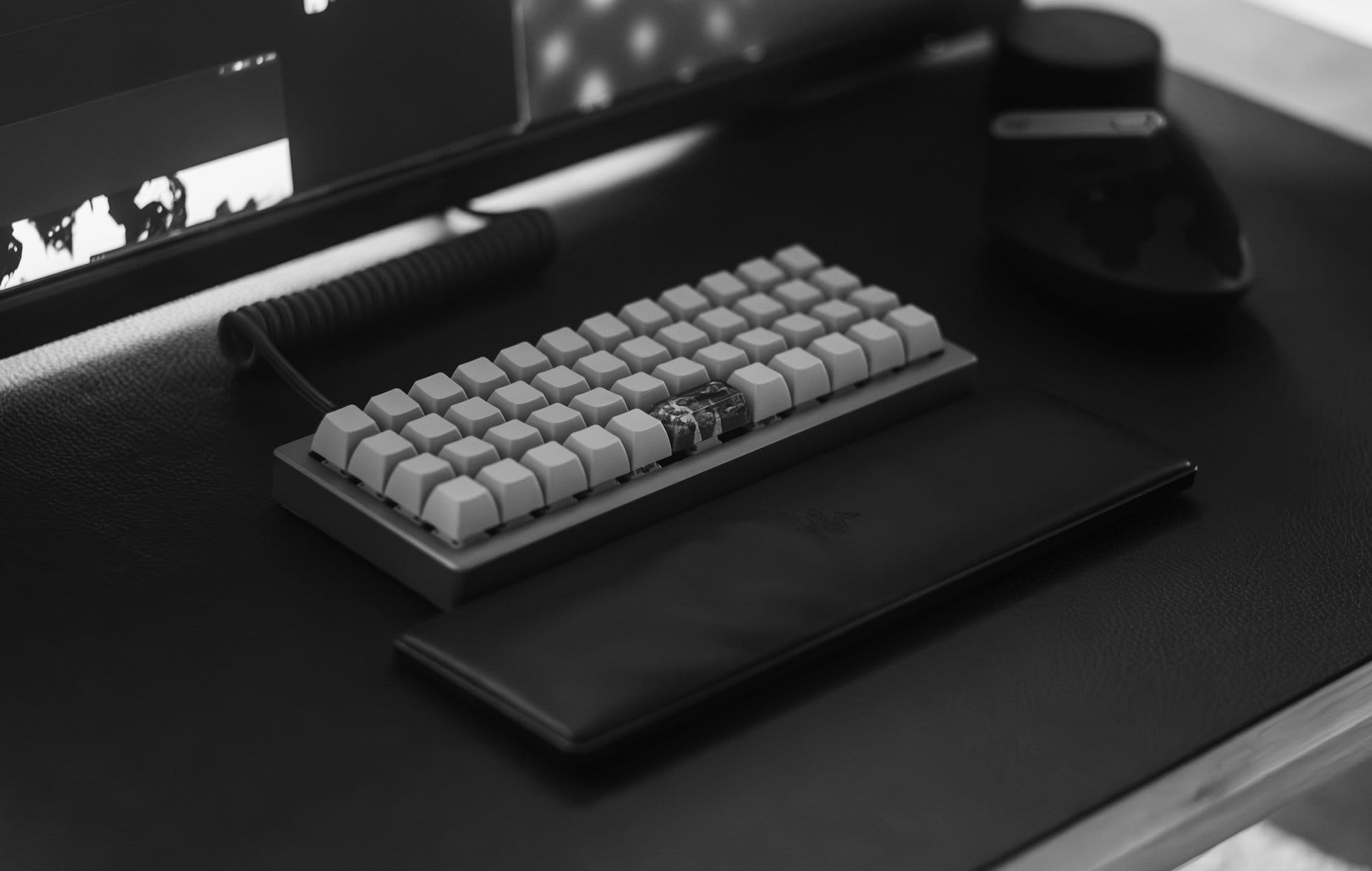
I also use it on the go thanks to a clever little accessory called the keybridg.
It’s basically a sturdy metal plate that allows me to place the keyboard directly over the built-in keyboard of my MacBook.
At first, I thought it was just a fun gimmick — but it turned out to be a game-changer for mobile productivity.
What apps or tools do you use to get things done?
The most essential tool in my workflow is a small but powerful app called Tot.
It’s a minimalist note-taking app with just seven simple pages — and that’s exactly what I love about it.
Tot lives in my Mac’s menu bar and is also pinned in the quick access area on my iPhone.
I use it for everything: private and work-related to-dos, important info, recipes, guides, and whatever else I need to quickly jot down.
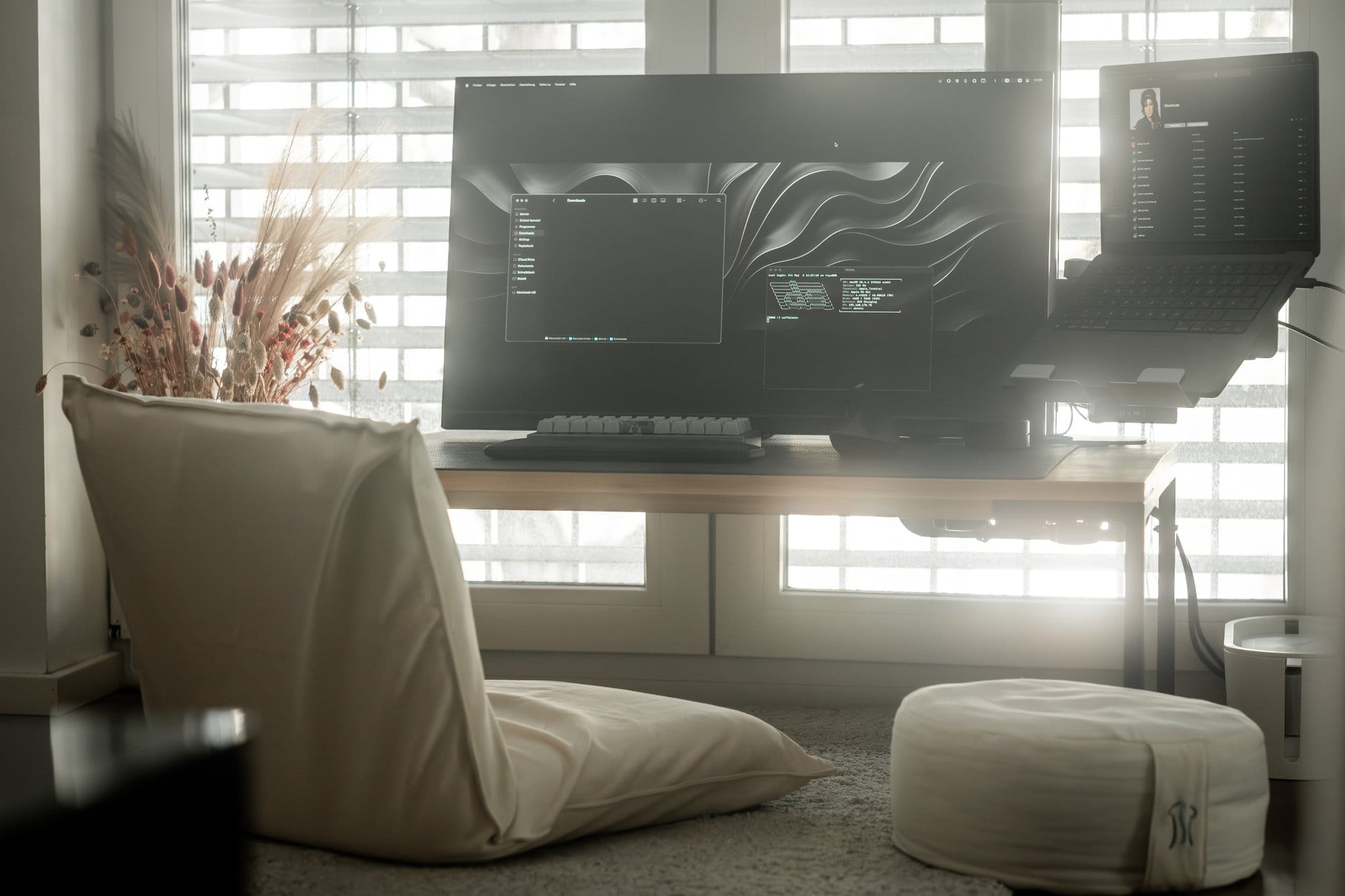
There’s no need for elaborate organisation — each of the seven pages has its own general category, and that’s enough.
It’s fast, always within reach, and helps me clear my mind.
I never worry about forgetting something, because it’s already noted down.

For me, this app perfectly embodies the principle of “less is more.”
Outside of Tot, I try to keep my Mac setup as clean and minimal as possible.
That said, I won’t pretend I didn’t put a lot of thought into how everything looks and feels — sometimes, simplicity requires the most planning.
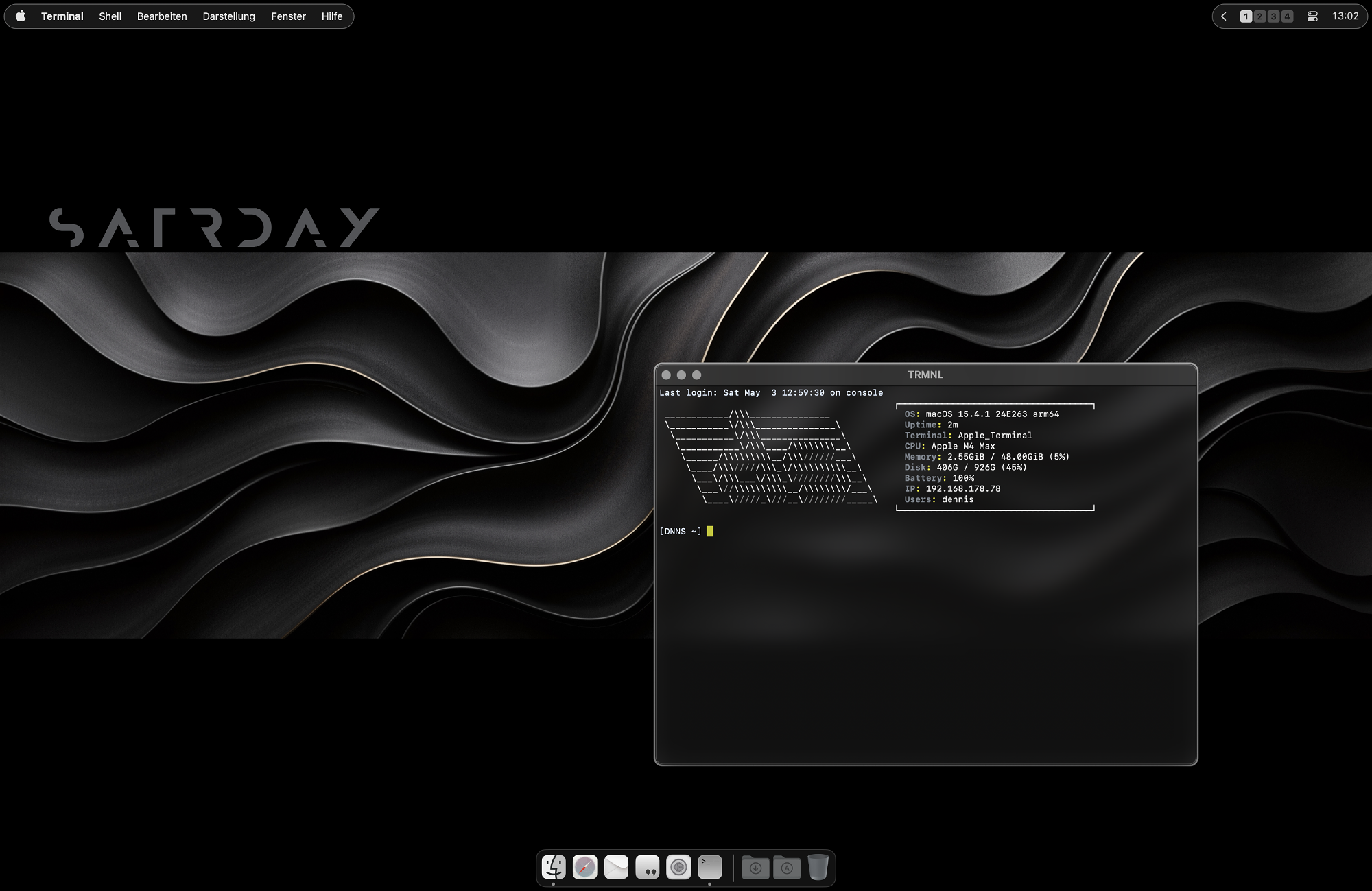
What books, blogs, or podcasts recently caught your attention?
To be honest, I don’t really read a lot of books or listen to many podcasts.
Instead, I spend a good amount of time on Reddit and YouTube, where I stay up to date and often educate myself — especially when it comes to my hobbies and interests.
One source of inspiration that really stood out to me is the YouTube channel Thoughtworthy Co.
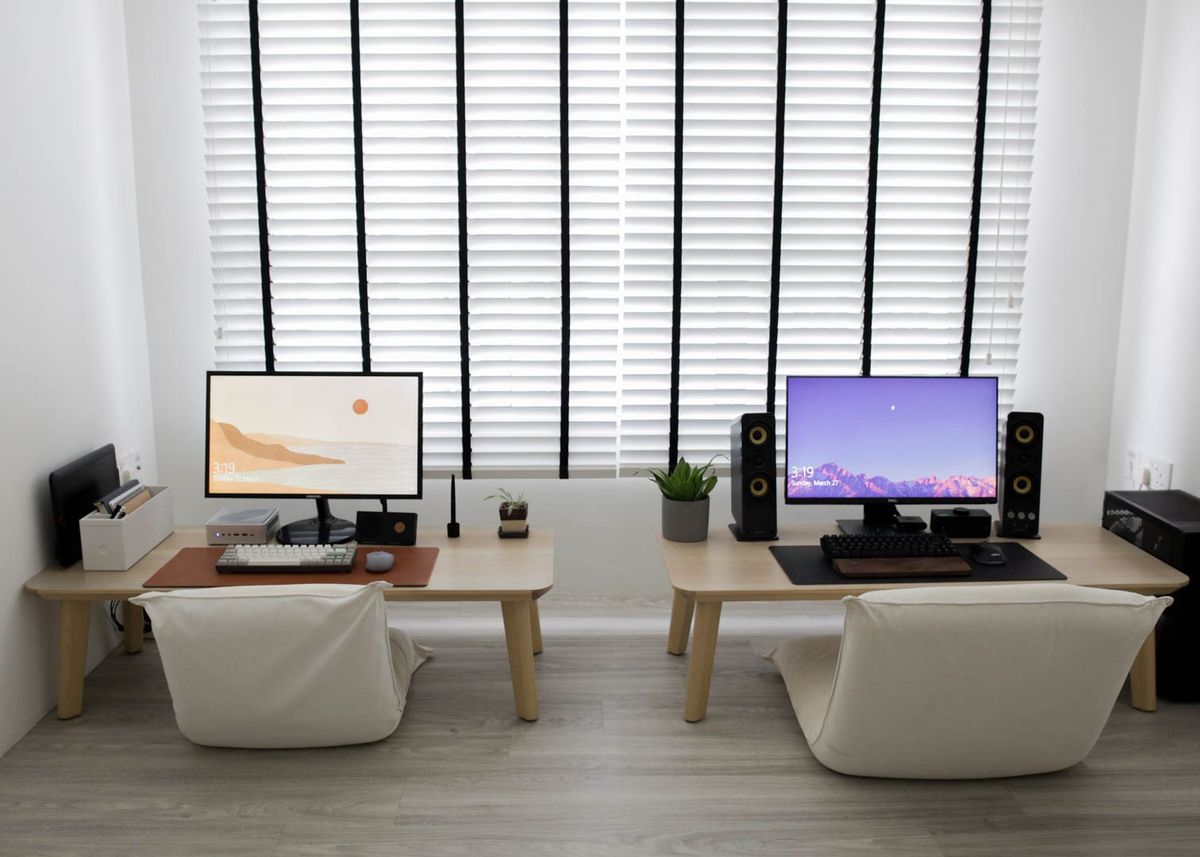
Their approach to minimalism, thoughtful design, and intentional living had a big influence on how I shaped my own workspace.
It’s not just about aesthetics — it’s about creating an environment that supports calm, focus, and creativity.
These kinds of platforms have become my go-to sources for discovering new ideas and perspectives in a way that fits naturally into my daily rhythm.
Any tips for other makers who want to improve their workspaces?
As I mentioned earlier —
Less is more.
My biggest advice is to focus on what you really need.
It’s easy to get swept up in all the impressive and aesthetic setups you see online, but a great workspace doesn’t come from copying others — it comes from understanding your own habits, preferences, and workflow.
That said, don’t be afraid to experiment.
Try things out, make changes, and allow yourself to grow through experience.
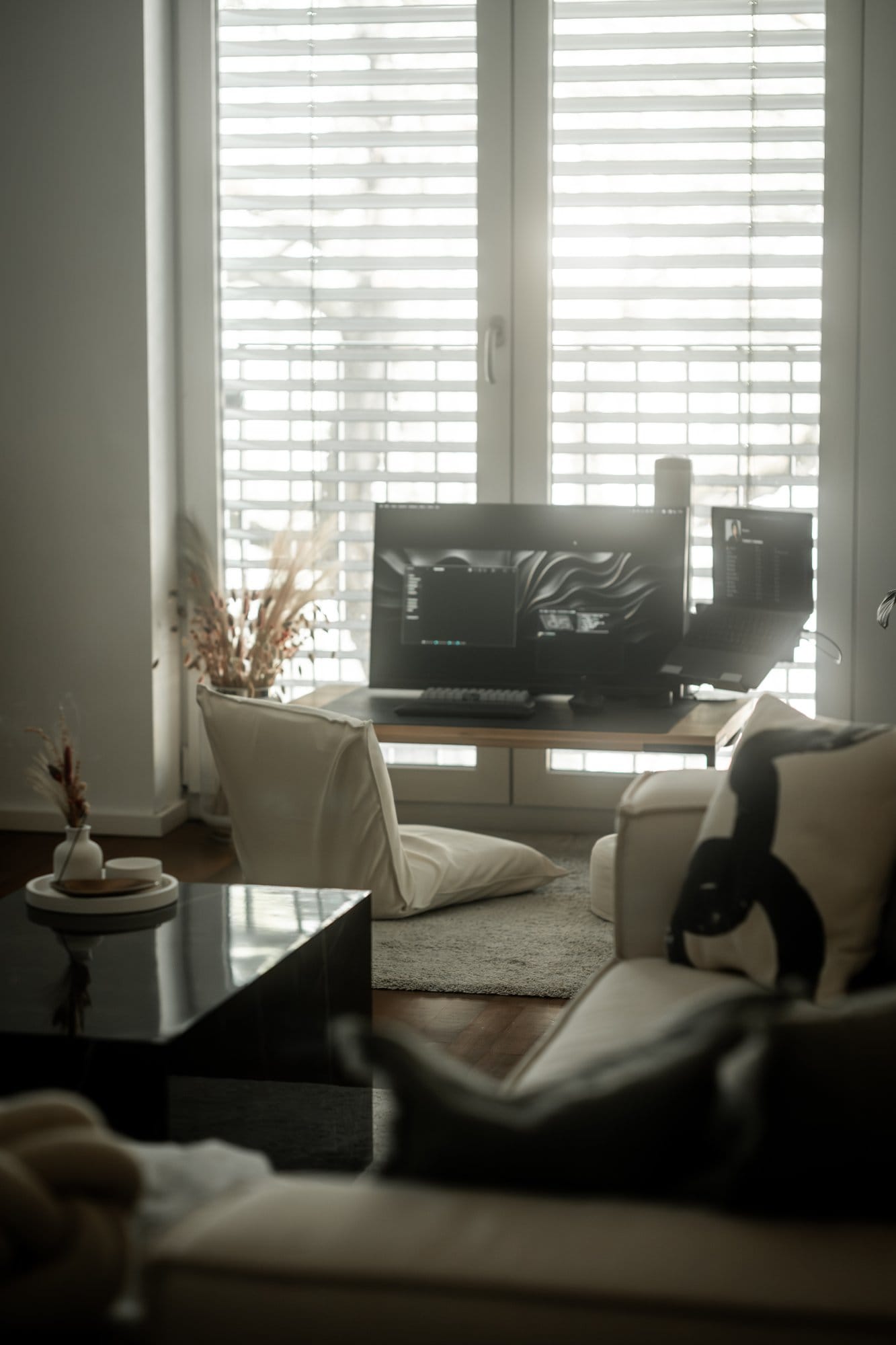
Over time, you’ll naturally discover what works best for you.
And most importantly: don’t put yourself under too much pressure.
Building your ideal setup should be fun, not stressful.
Enjoy the process — it’s all part of making a space that truly supports you.
What does your typical day look like?
I usually start my day around 9 a.m.
After a quick refresh, I kick things off with my team in our daily stand-up meeting.
Once that’s done, it’s time for my first coffee — I usually skip breakfast during the week and have an early lunch around 11 a.m. instead.
Breakfast is more of a weekend ritual for me.
My workdays are generally well structured, filled with meetings, but I always make sure to block time for focused work — whether it’s clearing out emails or tackling other tasks without distractions.
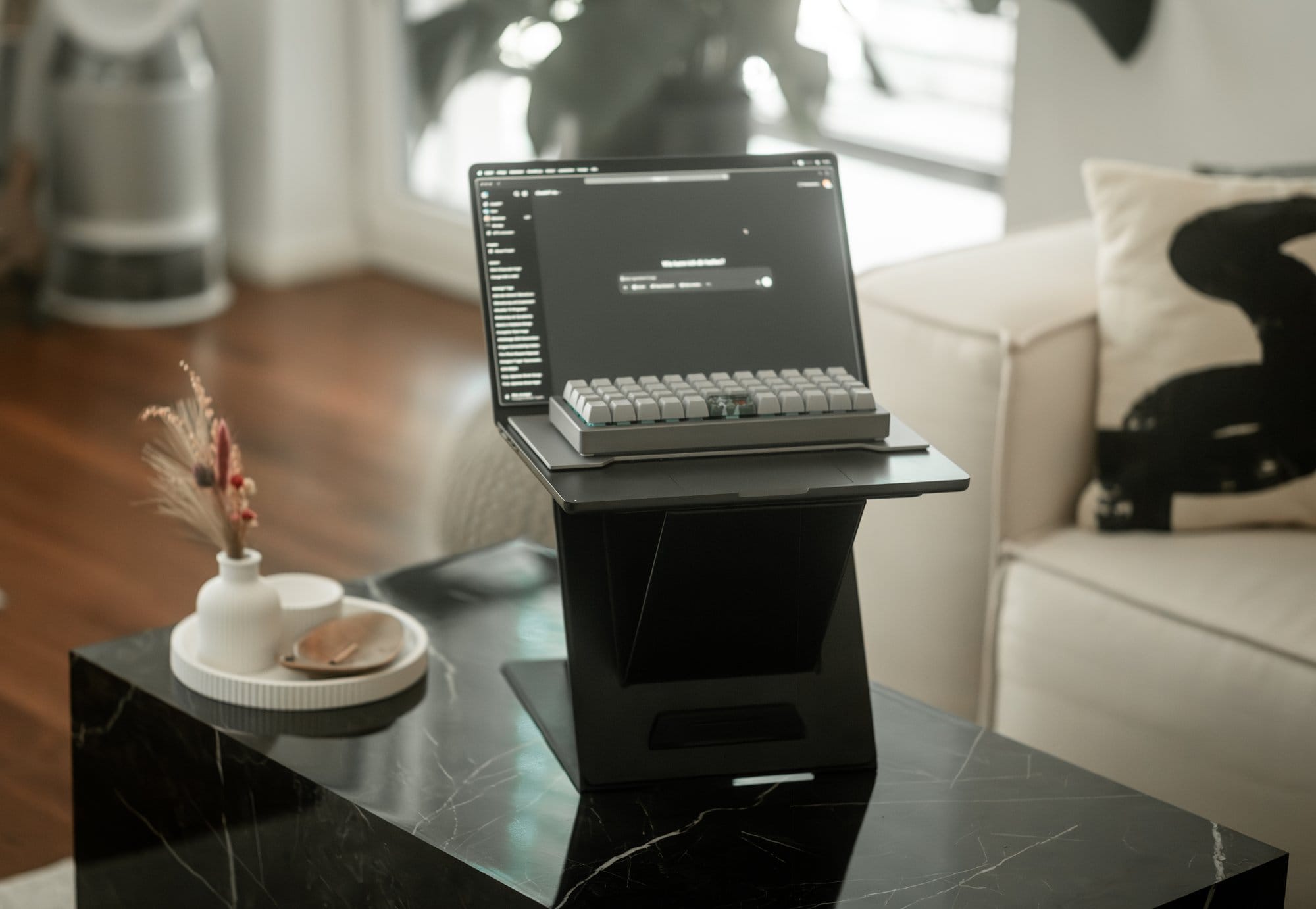
I also try to always be available and approachable to my colleagues.
Having open communication and staying connected with the team is something I really value.
Working from home gives me the flexibility to change locations throughout the day.
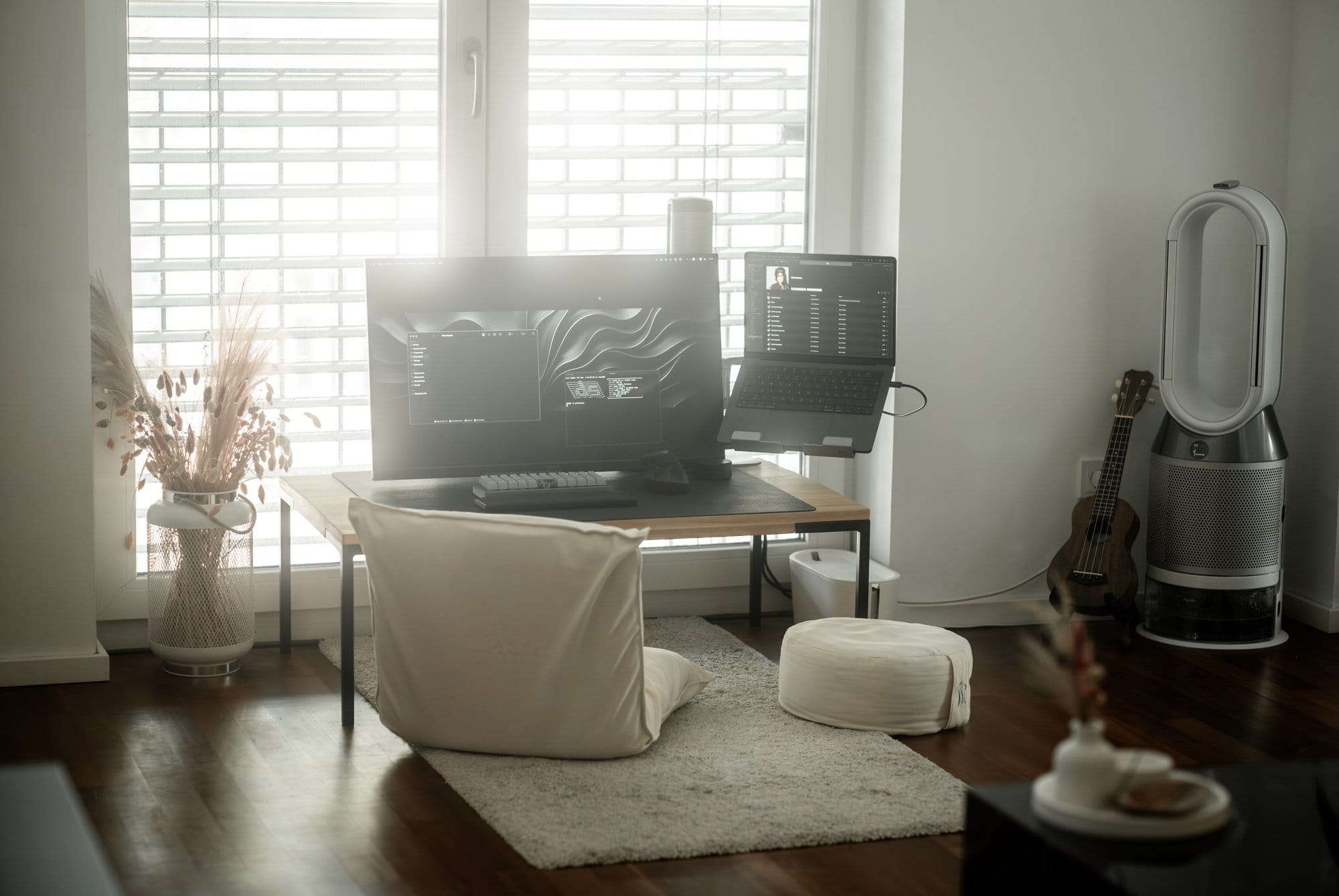
Most of the time, I sit at my floor desk, but I also like switching it up — sometimes I move to the couch or stand at the dining table using a foldable laptop stand.
After work, I often stay right at my setup — not because I have to, but because I genuinely enjoy being there.
It’s where I unwind, get creative, and most often dive into gaming, one of my biggest passions.
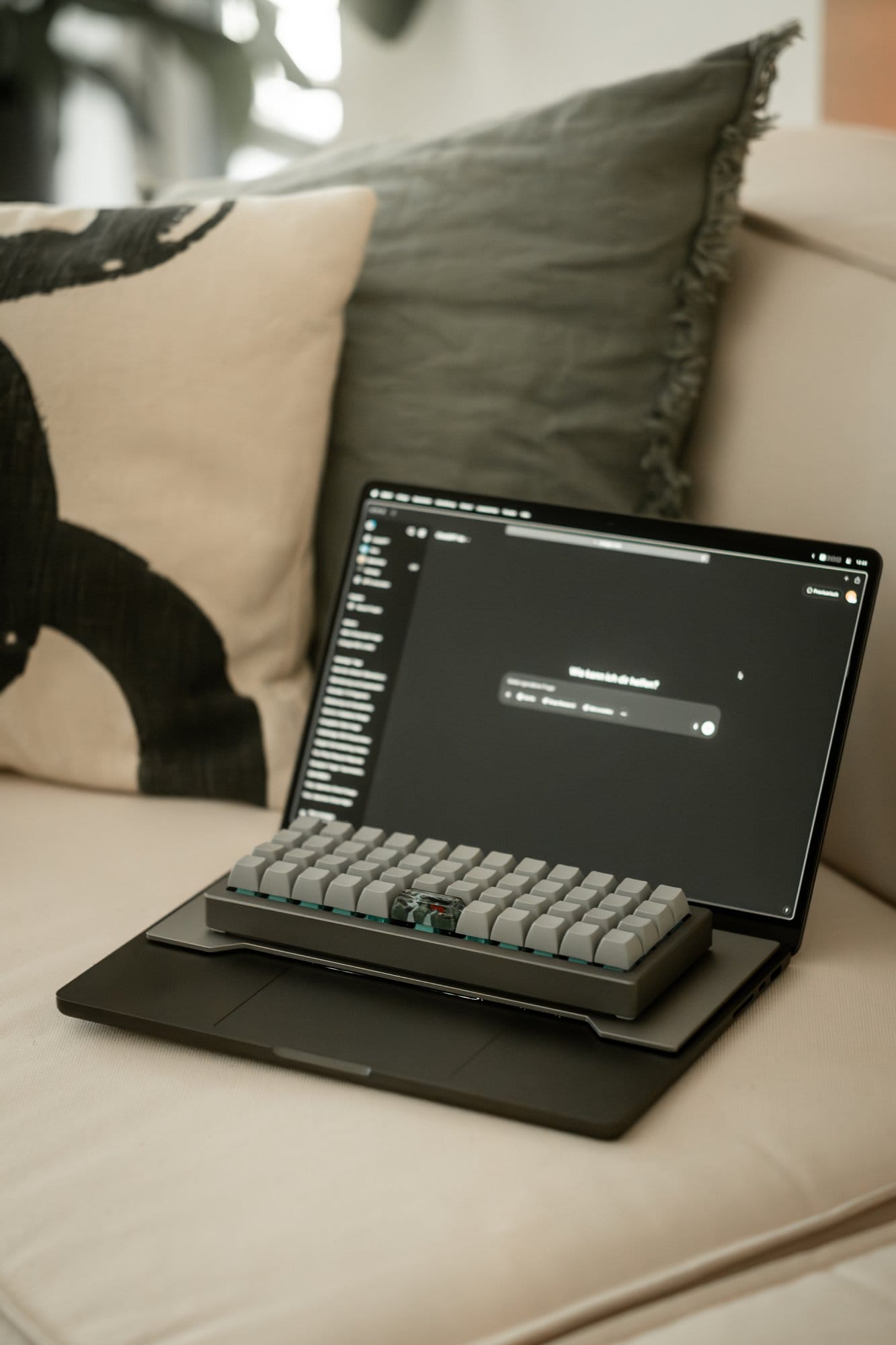
While I occasionally worked from home even before, the real shift came during the COVID-19 pandemic — and even more so when I moved into my role as a Scrum Master.
That change really cemented working remotely as my new normal — and I wouldn’t want it any other way.
Your tips for working from home?
Stay connected with your colleagues — seriously, don’t underestimate the social side of remote work.
I always encourage having webcams turned on during meetings.
Seeing each other helps maintain a sense of team spirit and keeps communication more human.
Mentally, it’s important to separate your “work mode” from your “home mode.”
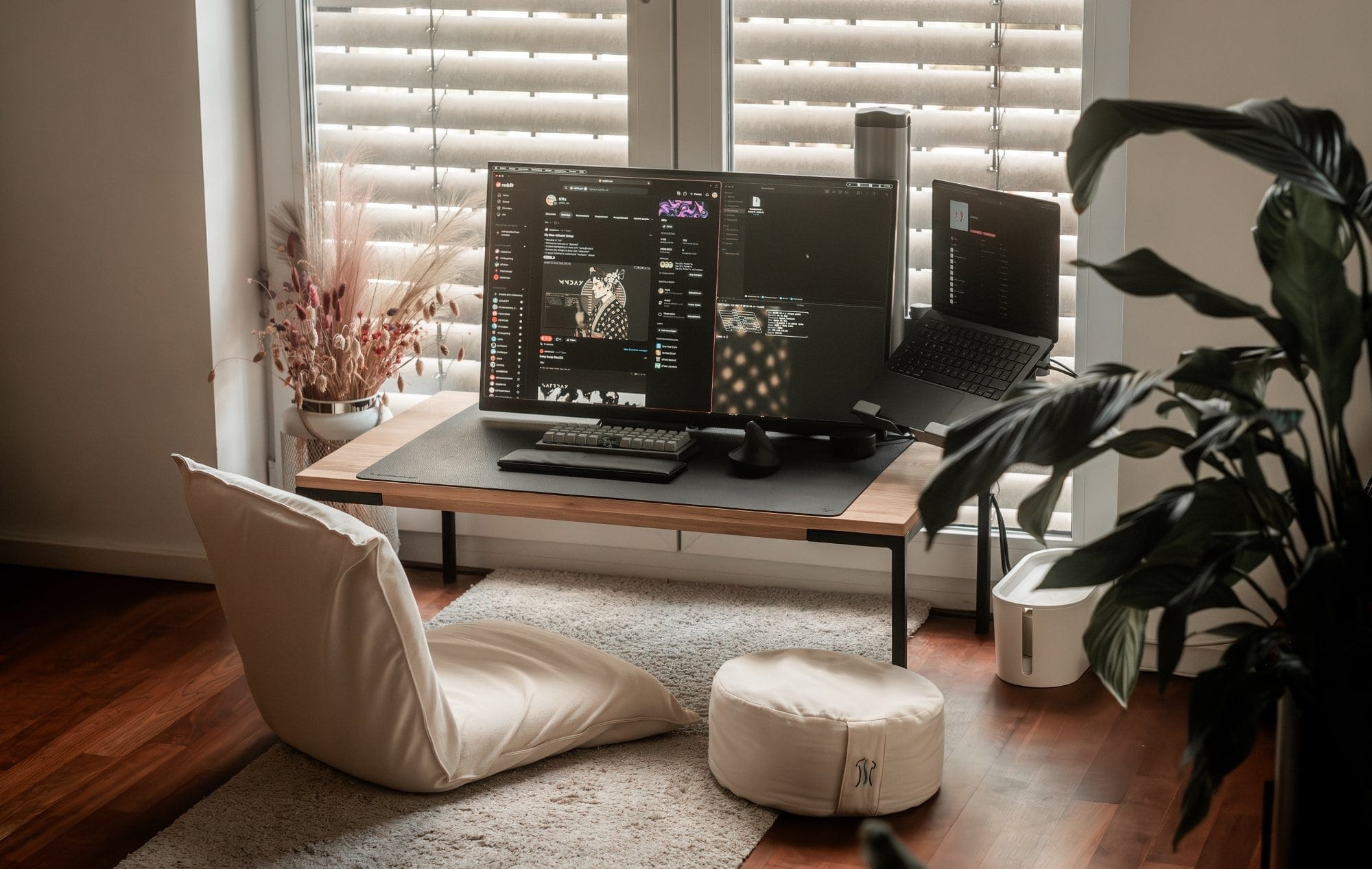
Just because you’re at home doesn’t mean you should let yourself be distracted by laundry or the dishes.
Create clear boundaries in your mind between work and personal life — it helps more than you’d think.
Also, don’t stay in one place for too long.
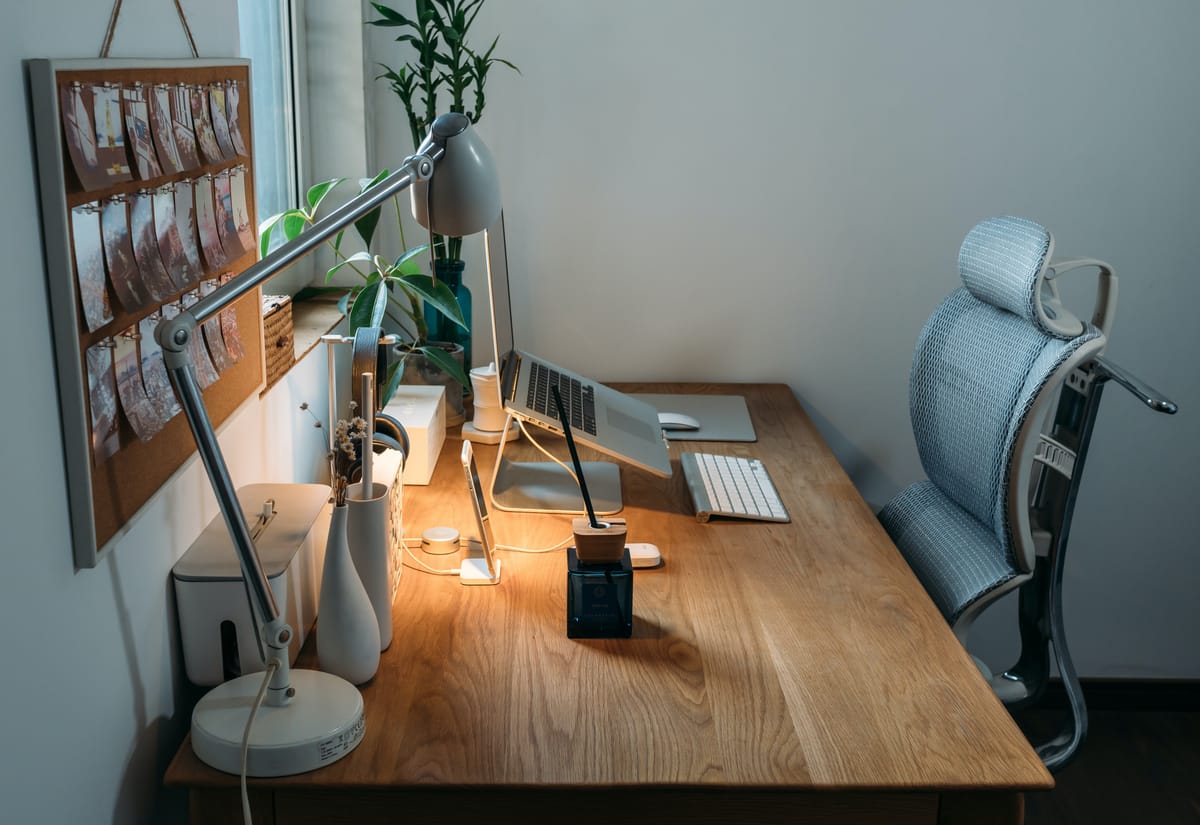
Change positions throughout the day if you can, even if you just stand up from time to time.
I sometimes take meetings on my phone and go for a walk around the block. Movement keeps your energy up and your mind fresh.
And last but not least: invest in a good coffee machine.
Trust me — it makes a big difference.
We’re a reader-supported publication. This article might contain affiliate links. It means we may receive a commission if you click a link and buy a product that our maker has recommended. The interview was done independently.

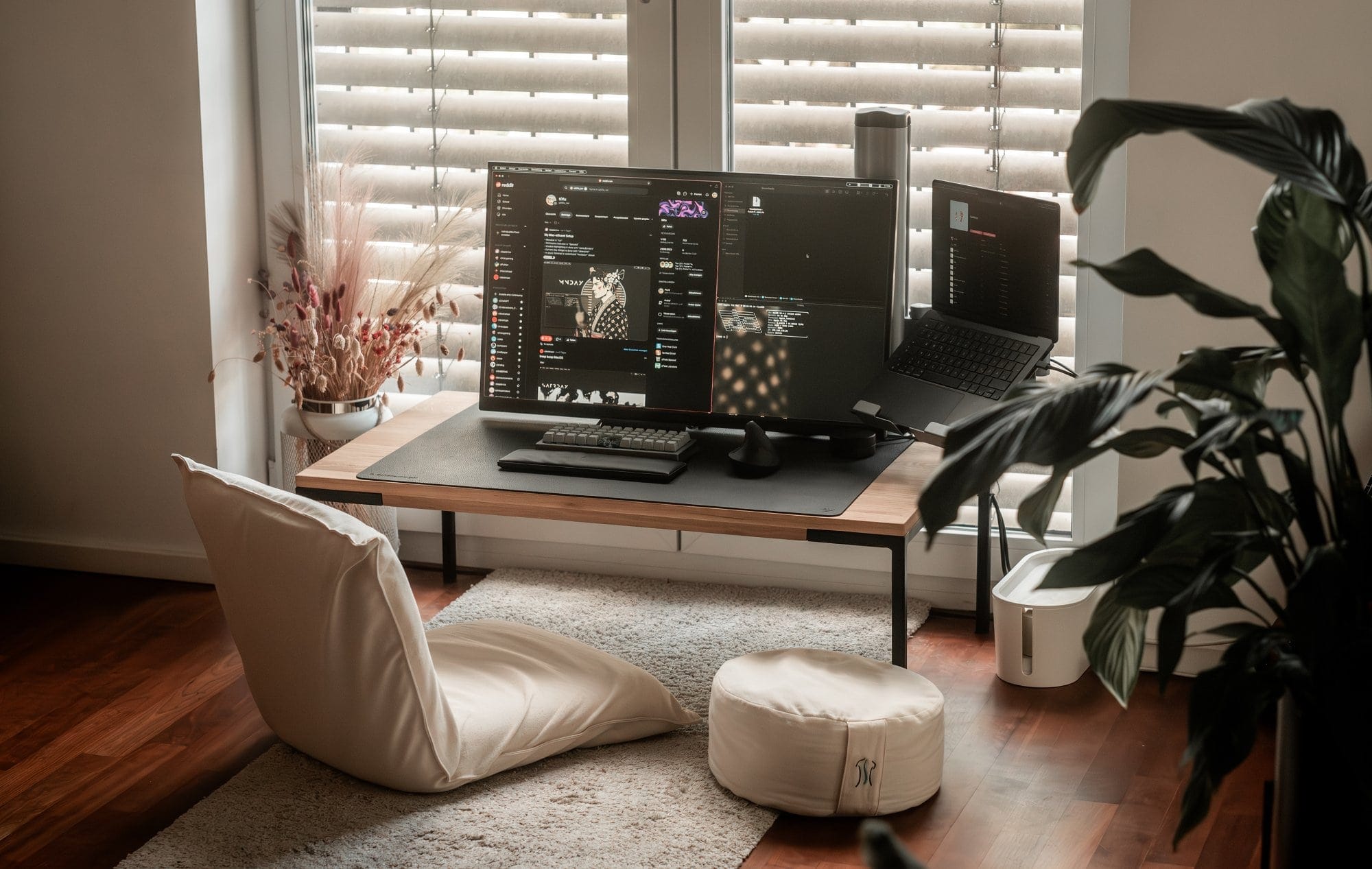


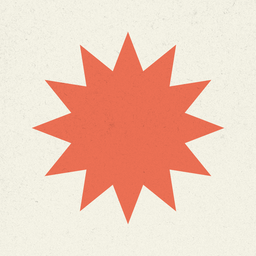

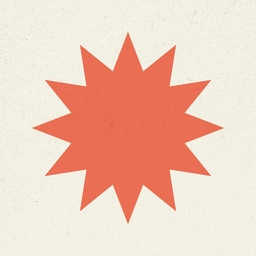
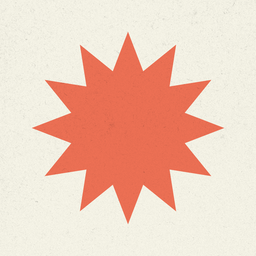
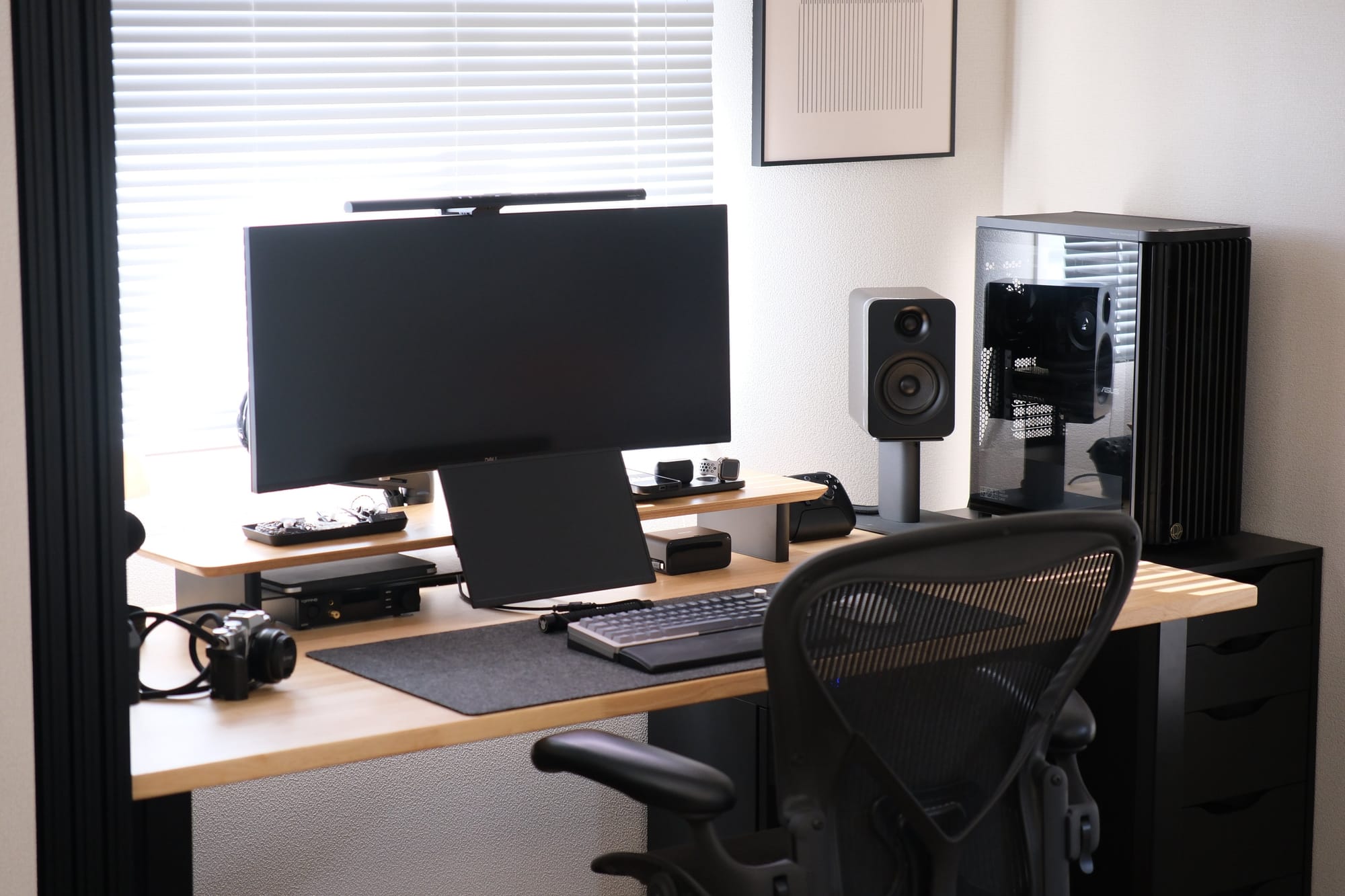
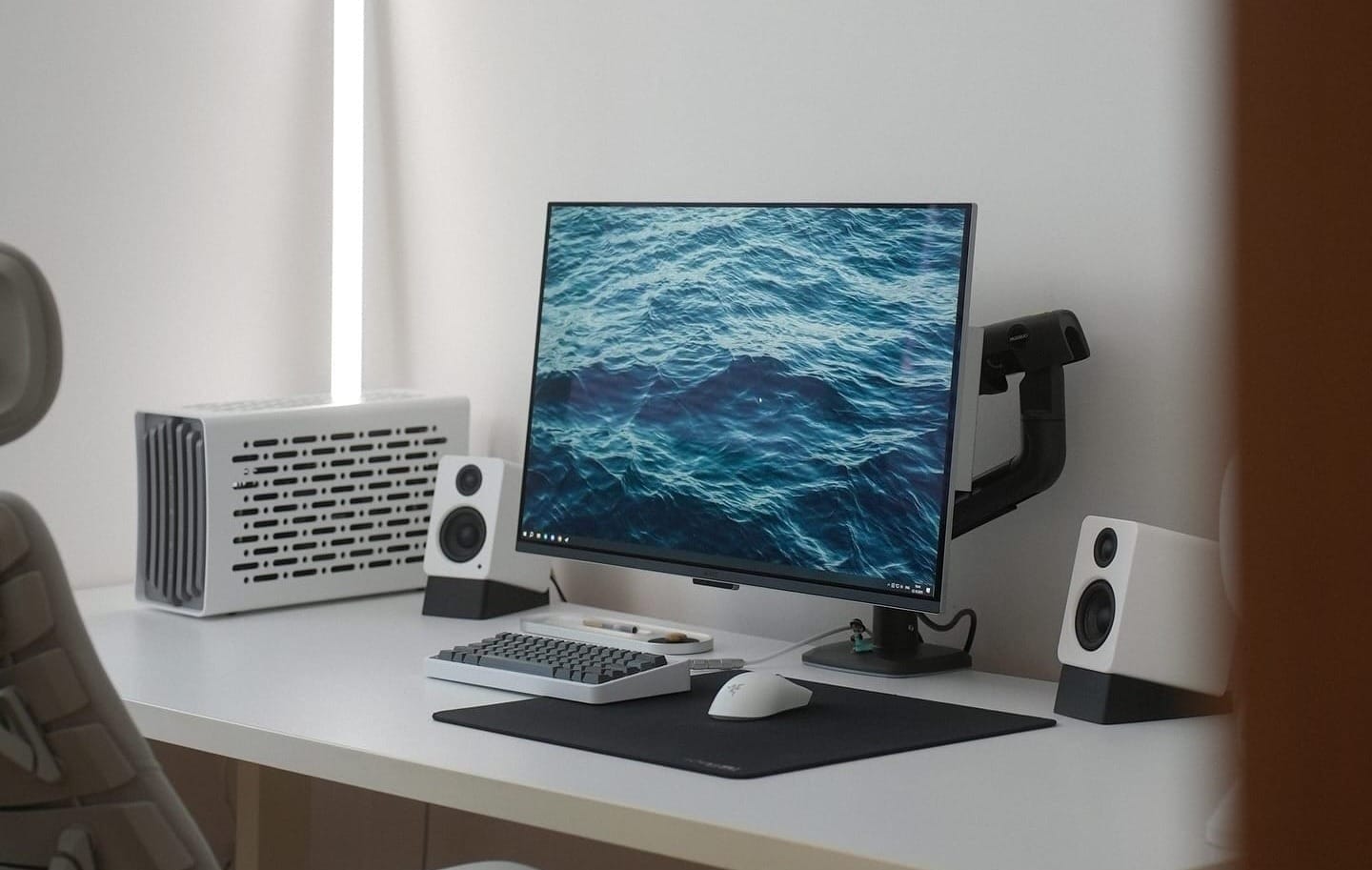

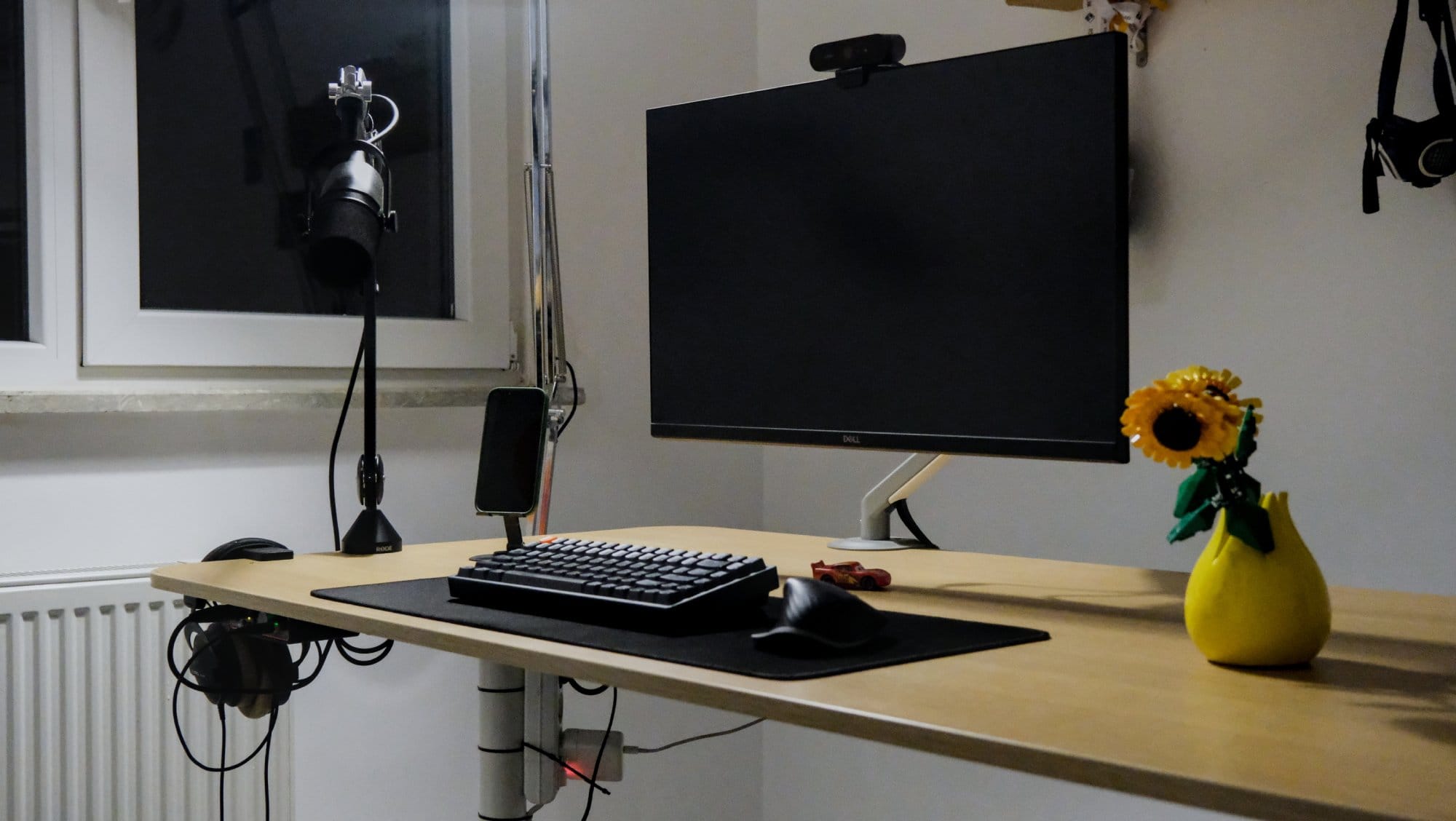
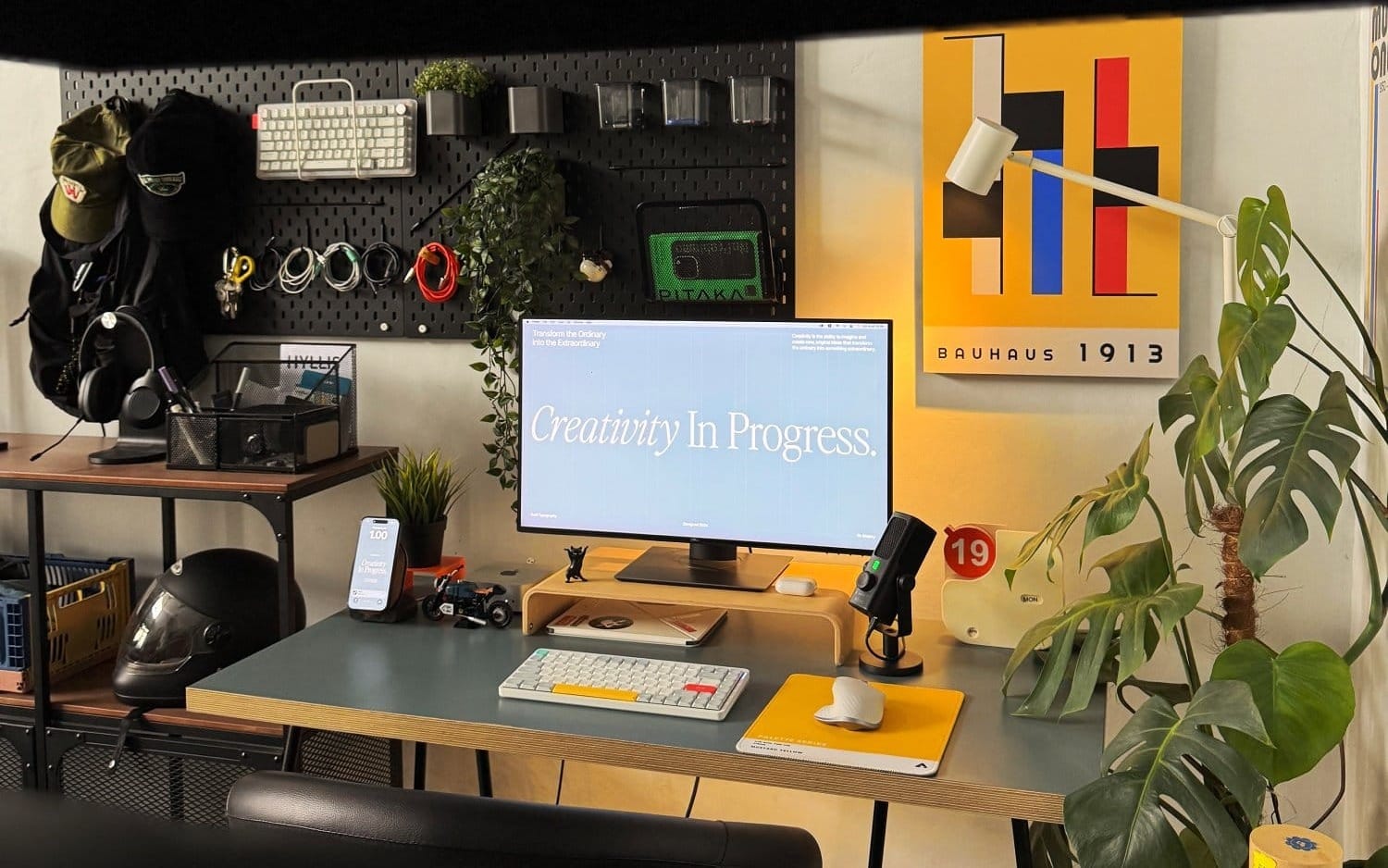
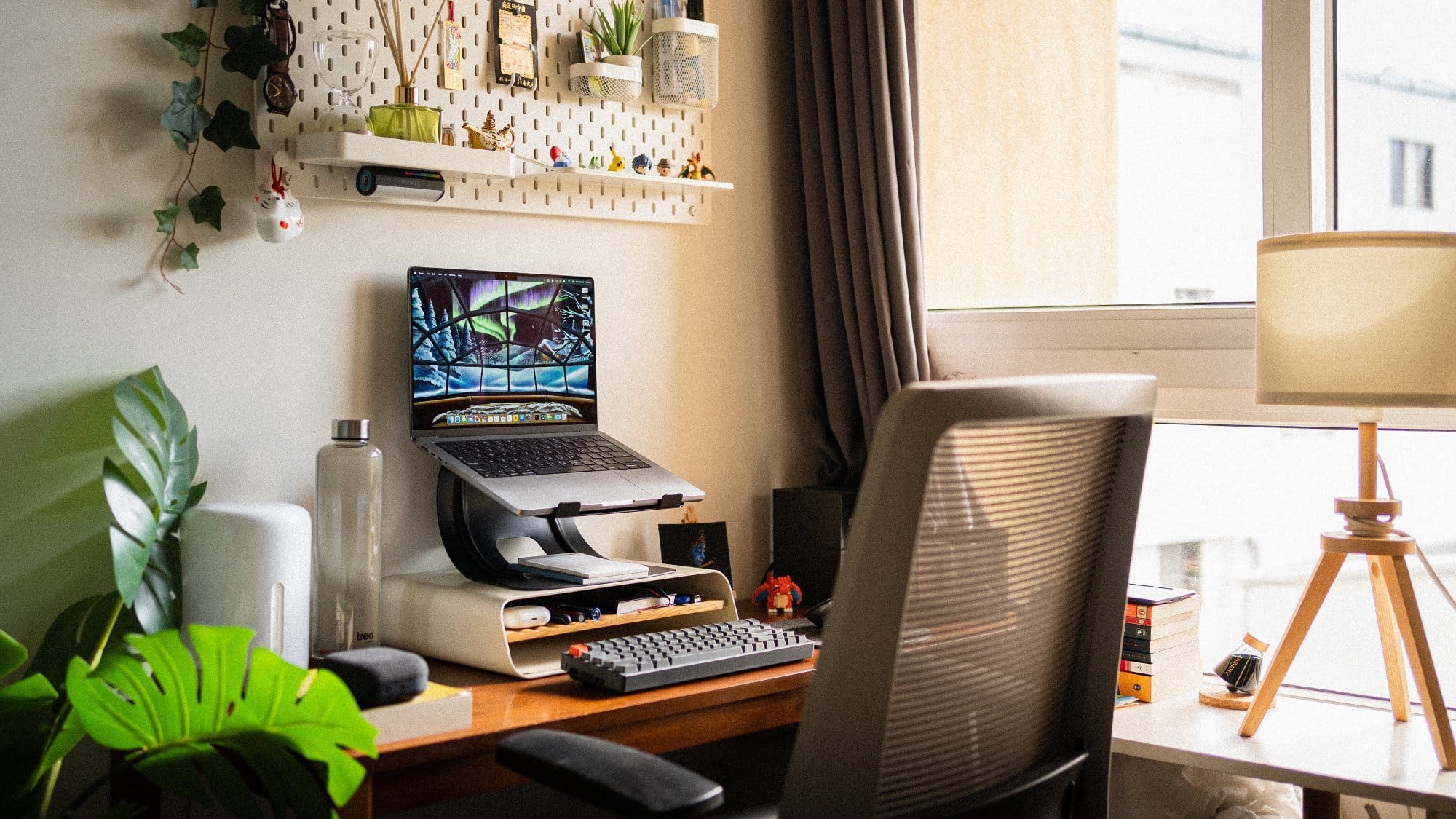
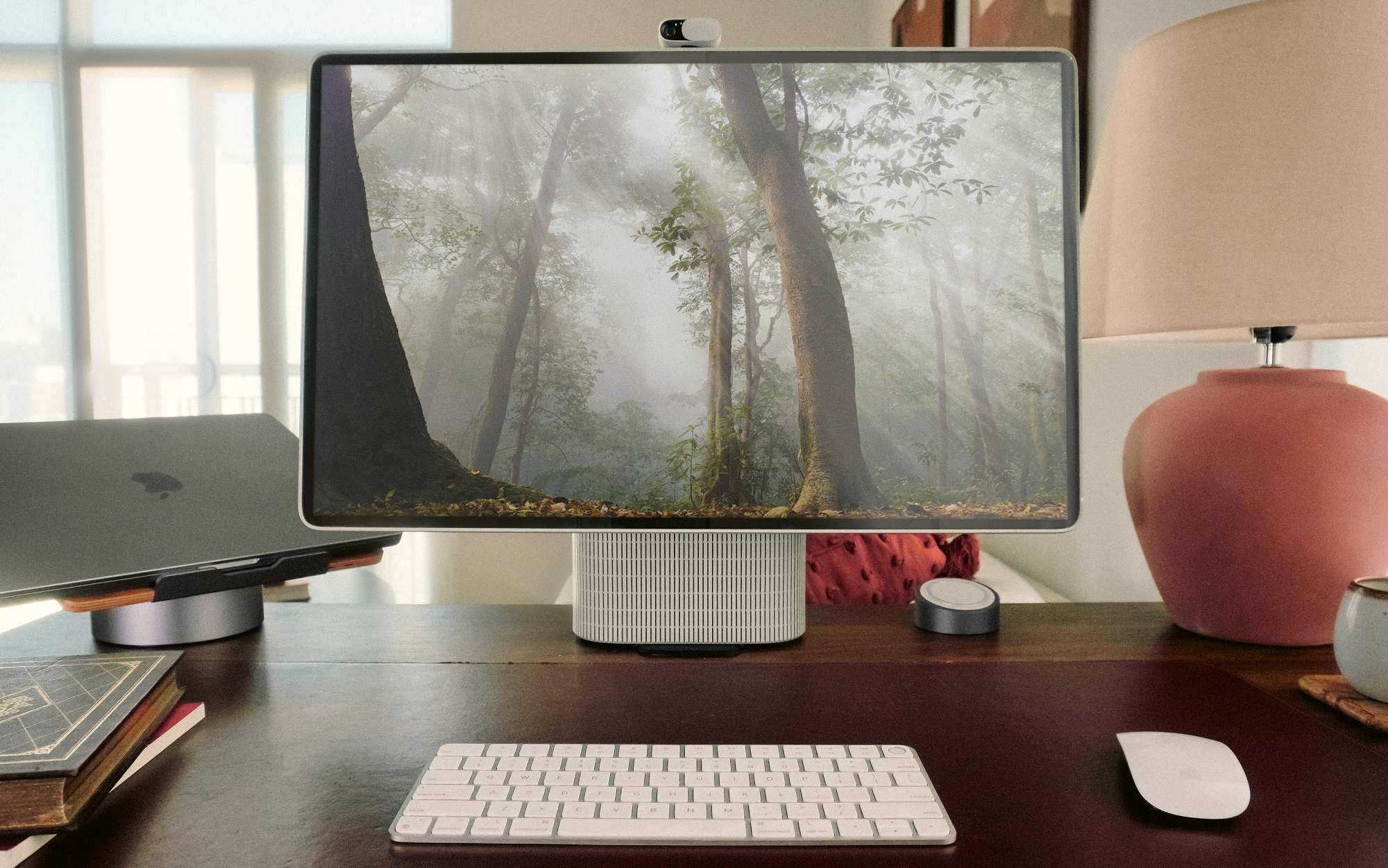

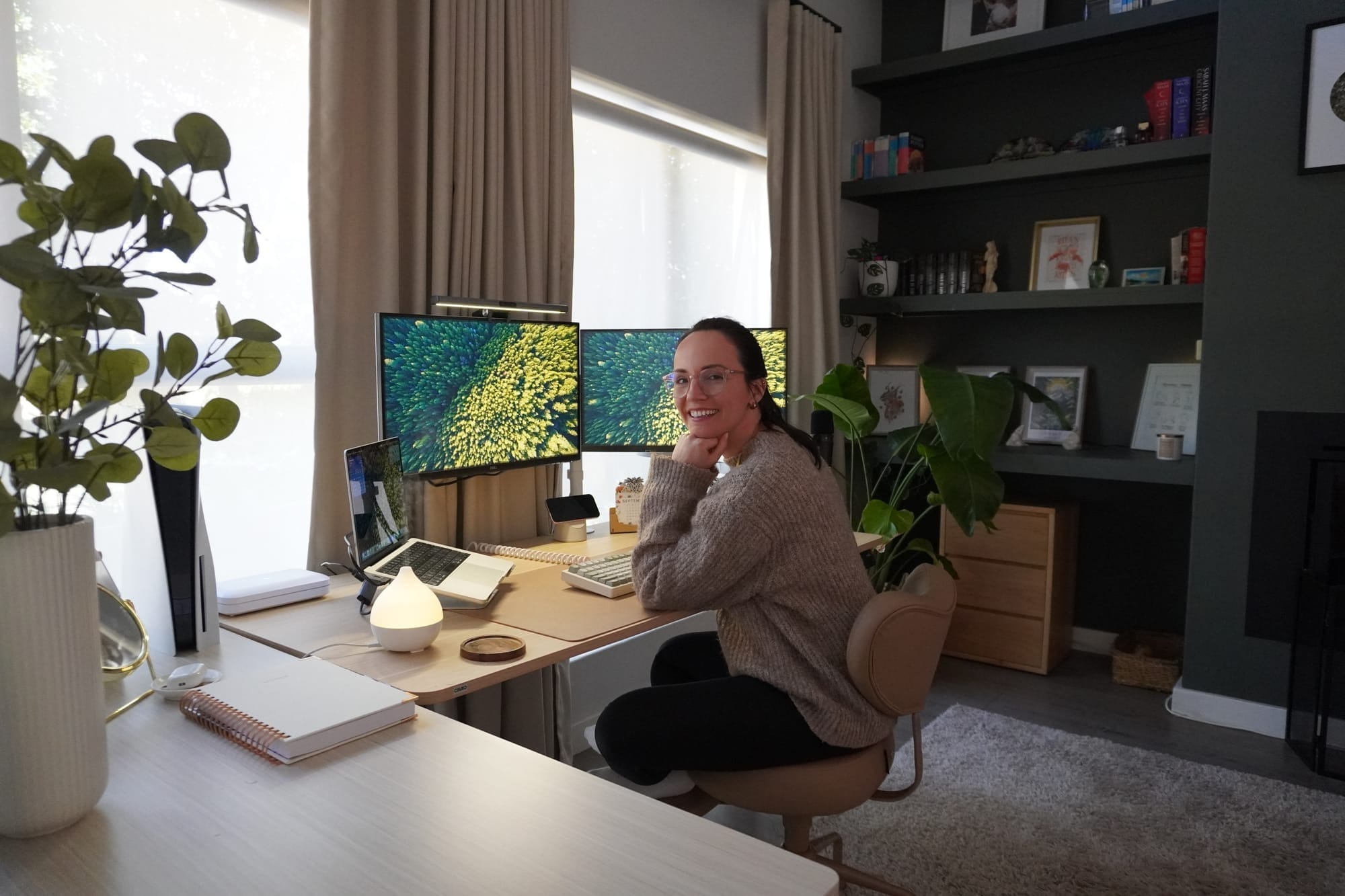
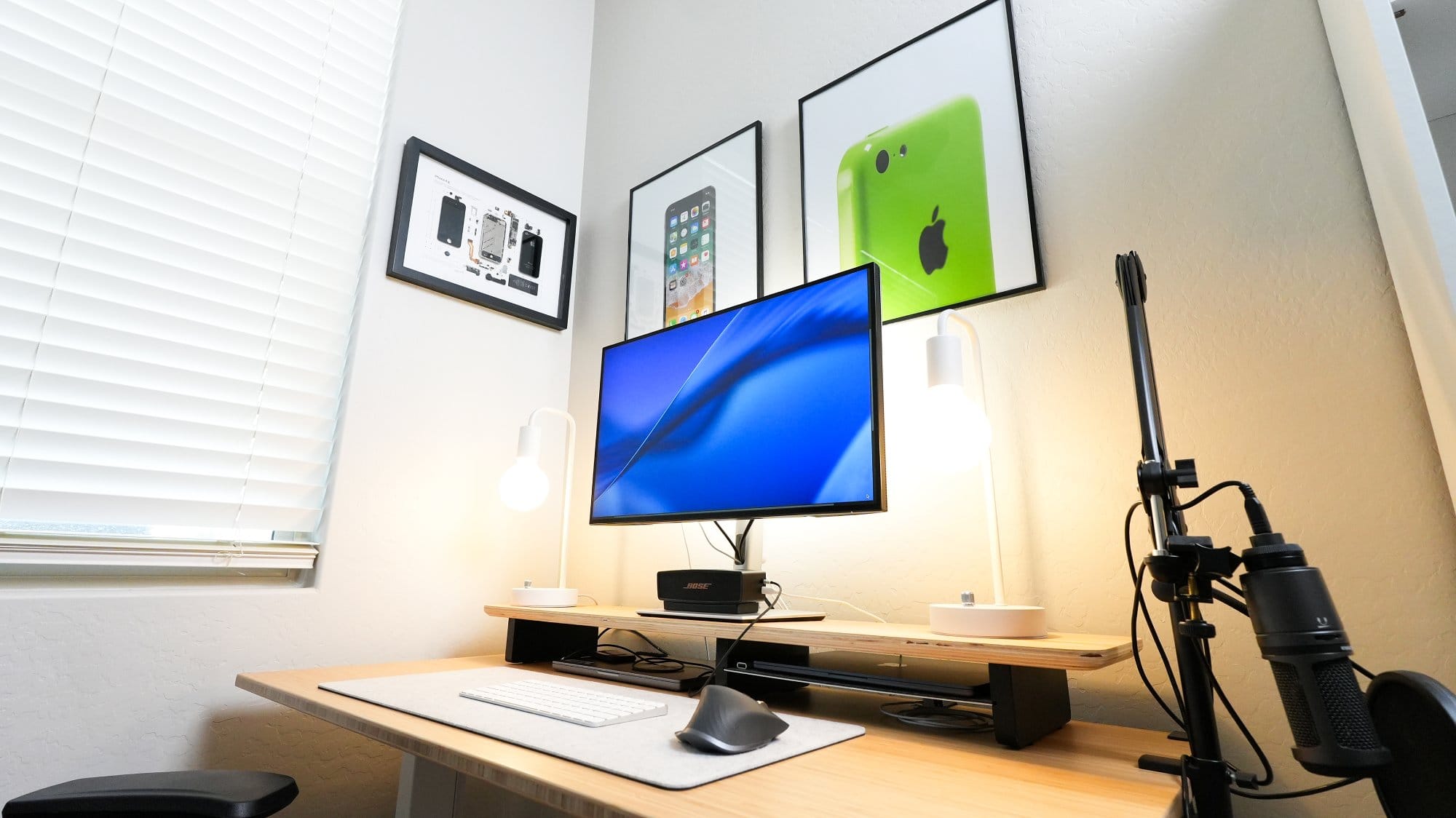
Discussion